
Set Description
US Gold Pattern Pieces- ANYTHING BUT GOLD
Sample set of gold pattern pieces struck in anything but gold
(Click on thumbnail to enlarge images)
Many sample gold patterns over the 19th century where stuck in metals other than gold and several of the copper only pieces were gilted to simulate the appearance of a gold coin. Starting in 1863 many trial pieces where struck in off metals, such as copper and aluminum, using the regular dies of the year. USPatterns.com states that these trail pieces were most likely just struck for sale to private collectors as year sets. Most of these pattern gold pieces (while scared to rare) are fun to collect with a simple type set goal in mind.
In this registry, I will display a few of the variety of pieces that I have collected and they represent some of the unique designs and trials by the mint. There are still several wonderful designs I wish to seek out but chances are the cost may be out of my reach. I am also attempting to collect a type set of those regular gold dies struck in copper (1$G through 20$G samples).
 I start with the patterns of 1852, where this was another attempt by the mint to find a design for small denomination gold pieces to be easier to handle. This ring form design allowed the mint to increase the size of a 1$ gold piece to be used in commerce. Just compare the tiny 1$ gold pieces of 1853 to these larger diameter trials of 1851. The mint had used this ring-form approach in 1850 & 51 in the opposite direction to tried to find a small cent replacement for those large Bulky 1C pieces.. I start with the patterns of 1852, where this was another attempt by the mint to find a design for small denomination gold pieces to be easier to handle. This ring form design allowed the mint to increase the size of a 1$ gold piece to be used in commerce. Just compare the tiny 1$ gold pieces of 1853 to these larger diameter trials of 1851. The mint had used this ring-form approach in 1850 & 51 in the opposite direction to tried to find a small cent replacement for those large Bulky 1C pieces..
 The Judd-272 was a sample of the mint fight against fraudulent activity and gold manipulation by striking a half eagle on a broad / thinner planchet, These planchet were of large diameter like a 10$ piece It was uncovered by the mint that unscrupulous people would cut an eagle in half and remove the gold from the center and replace with it other material. Andrew Pollock in his reference, sties platinum was used as a filler which at that time had a lower value than Gold ... Go figure! The J-272 obverse was of Longacre’s Liberty Cap and the reverse was attributed to Paquet. The Judd-272 was a sample of the mint fight against fraudulent activity and gold manipulation by striking a half eagle on a broad / thinner planchet, These planchet were of large diameter like a 10$ piece It was uncovered by the mint that unscrupulous people would cut an eagle in half and remove the gold from the center and replace with it other material. Andrew Pollock in his reference, sties platinum was used as a filler which at that time had a lower value than Gold ... Go figure! The J-272 obverse was of Longacre’s Liberty Cap and the reverse was attributed to Paquet.
 A dual currency piece of 1868 is of great interest , the Judd-659. The international monetary meeting in 1867 discussed establishing an international gold currency standard based the French Franc. The J-659 was the output of the US effort towards this concept. The weight for 5$ gold piece would be reduced to basically equal 25 French Francs at the time. Paquet designed the piece but the international standard concept never materialize and was restudied in later years. A dual currency piece of 1868 is of great interest , the Judd-659. The international monetary meeting in 1867 discussed establishing an international gold currency standard based the French Franc. The J-659 was the output of the US effort towards this concept. The weight for 5$ gold piece would be reduced to basically equal 25 French Francs at the time. Paquet designed the piece but the international standard concept never materialize and was restudied in later years.
Click here Return to Mania's Master Pattern Listing
Mania's US Patterns- WHAT U.S. COINAGE COULD HAVE BEEN
---------------------------------------------------------------------------------
Set Goals
Collect interesting looking gold patterns while also assembling a type set of US gold pieces struck with regular dies of year (in Copper) 1$ through 20$ .
%20update%20feb%202023.jpg)
Eagles Trials with "GOD OUR TRUST"
 Copper / GILT Sample Set "
Copper / GILT Sample Set "

| | | | | | |
| | | | | | |
|
View Coin
| J-70 1$ Gilt |
United States
|
G$1 1836 J-70 GILT
|
PCGS PF 64
|

1836 PG$1 Gold Dollar
Judd-70 Gilt, Pollock-73
Rarity: Low R.7, PR64, CAC Endorsed
Ex: Simpson.
Struck in copper with a plain edge, and gilt
Obverse: The obverse displays a Liberty cap surrounded by a glory of rays with LIBERTY on the band, a motif reminiscent of the various Mexican silver coins of one to eight reales and fractions thereof that appeared in 1824.
Reverse: The reverse shows 1 and D. on two lines enclosed by a graceful palm frond, with the date below and UNITED STATES OF AMERICA around the rim..
Comment: The copper pieces are believed to be restrikes and only a dozen or so are known. This is a bright yellow-gold example that resembles a gold striking, just lacking the depth of mirroring one would see on a proof gold coin.
Dies by Christian Gobrecht, who interrupted his work on the second obverse of the silver dollar to complete these dies. Pieces were struck before March 14, 1836, as a letter of that date from the Mint Director to the Secretary of the Treasury enclosed a specimen in gold. The obverse design with Liberty cap surrounded by rays was directly copied from the series of silver coins struck by the Mexican Republic starting in 1823. Gobrecht had used the same design a few months before on his mint medals dated Feb. 22 and March 23, 1836 for the first steam coinage at Philadelphia (Qulian MT-20,21). Nearly the same designs (obverse and reverse) were used again in 1850 on a silver trime pattern (J-125), with the date moved to the obverse
Provenance/Appearances:
Ex: Bob Simpson, Heritage May 2022 CSNS/ Lot #3628; ; Prior
- Paramount Apr 1981 (Sutherland Collection) /Lot #2;
- Bowers & Merena Feb 1987 / Lot 2267
Video Link by Heritage on J-70 Not my specific coin but similar
|

|
|
View Coin
| J-140 G1$
Struck in Copper-Nickel
Ring type |
United States
|
G$1 1852 J-140
|
PCGS PF 64
|

1852 G$1 Annular Dollar in Copper-Nickel
Judd-140, Pollock-167
Rarity: Low R.7 PR64
Struck in copper-nickel with a plain edge.
Obverse: Only USA above the hole with 1852 below,
Reverse: A series of laurel sprigs amidst heavy concentric die lines. Curiously, no denomination is stated.
Comment:
One of the proposed solutions to the problem of the undersized and easily lost gold dollar was an annular pattern. The large center perforation (as struck) and narrow margin forces a simple design. Curiously, no denomination is stated.
The surfaces have toned a light brown but still retain the distinctive underlying golden-tan color common to copper-nickel alloy. Original, untampered surfaces with a couple of small, dark incrustations on each side.
Provenance/Appearance:
Private sale Jan 2019; Prior Heritage June 2017 Long Beach Expo Auction / Lot #4021
|

|
|
View Coin
| J-148 G1$
Stuck in Copper-Nickel
Ring type |
United States
|
G$1 1852 J-148
|
NGC PF 65
|
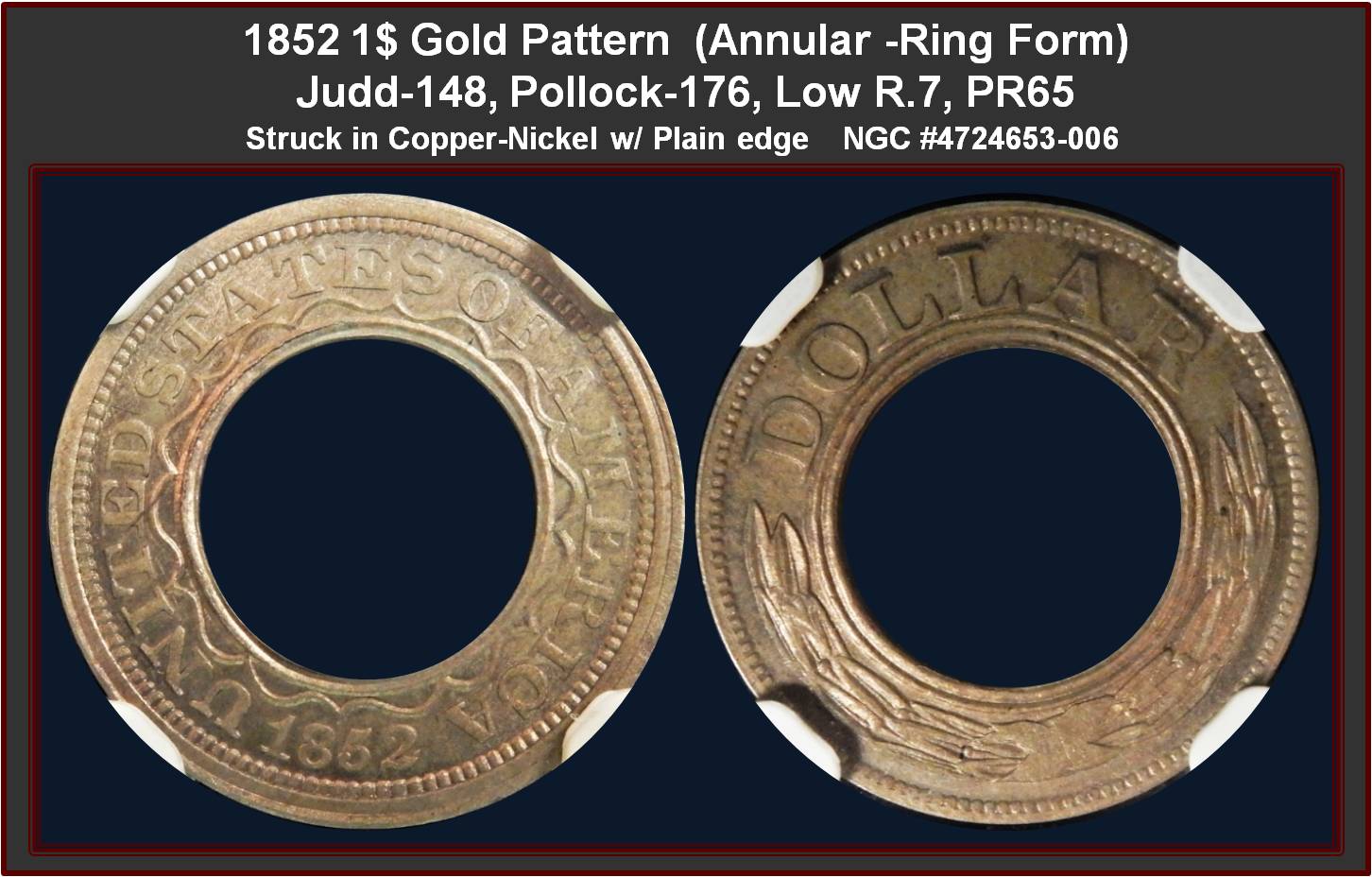
1852 G1$ Annular, or Ring-Form Pattern Gold Dollar
Judd-148, Pollock-176
Rarity: Low R.7 PR65
Annular gold dollar. Struck in copper-nickel with a plain edge.
Obverse: Annular gold dollar with perforation and UNITED STATES OF AMERICA and 1852 around ornamented raised rim.
Reverse: the simple wording for denomination "DOLLAR" and a wreath around a raised rim.
Comment:
A very interesting concept for the gold dollar. Starting in 1849 with the mass outpouring of gold from California, gold dollars were struck, but were tiny. In an effort to make the diameter larger and still maintain the legislated weight, a larger planchet was produced with a perforated hole in the center punched out
With the vast quantity of gold coins in circulation as a result to the California Gold Rush, the value of silver rose in relation to the price of gold, and silver began to disappear from circulation, particularly the silver dollar. As a result, many gold dollars were struck during these years where the silver dollar mintage dropped. The gold dollar as it was minted was small, and in an effort to enlarge the diameter of the denomination, the Mint experimented with these annular or ring shaped designs. Pollock designates the Judd-148 as "Probably a restrike," and notes that "thick and thin planchet varieties exist, per the Adam
Provenance/Appearance:
Private sale June 2019. Could not locate prior appearance
|

|
|
View Coin
| J-189 2.5$ gilt |
United States
|
$2.5 1857 J-189 GILT
|
NGC PF 64
|

1857 P$2 1/2 Quarter Eagle,
Judd-189, Pollock-226,
Rarity: Low R.7, PR64 Gilt
Ex: Bass
Plate piece in Pollock reference book Fig 89
Struck in Copper ( Gilt) with Reeded Edge
Obverse: The obverse depicts the portrait of Miss. Liberty facing left, with a coronet inscribed LIBERTY, virtually identical to that used on nickel three-cent pieces first made in 1865. At that later time Longacre did the easy thing and copied his 1857 die.
Reverse: An eagle with wings raised, having a shield on its breast. Three arrows and an olive branch are held by its claws. Around, the legend UNITED STATES OF AMERICA, and below, the denomination 2 1/2 D. The reverse design is in the style of Anthony C. Paquet, featuring a rather “surprised” appearing eagle— with thin wings, holding the requisite olive branch and arrows. Inscriptions in letters of the Paquet style surround.
Comments:
Light cameo contrast is evident on the brilliant yellow surfaces of this lovely pattern. A few scattered toning spots on each side may limit the grade, but they also provide convenient pedigree identifiers.
This is the low date variety with the digit 7 distant from Miss Liberty’s hair curl. This variety was discovered by Harry Bass who, during the 1970s, spent quite a bit of time studying patterns carefully under high magnification. His quest for different variations in punctuation, date placement, etc., explains his acquisition of multiple examples of certain.
Technical Aspects: Weight: 37.9 grains. Diameter: 17.7 mm. Die alignment: 180°. Die notes: On the present coin the date is lower in the field, with the 7 being about equidistant between a dentil and the curl.
Provenance/Appearances:
From The Estate of Charles W. Montgomery. Heritage Nov 2023 Dallas / Lot #3273: Priors
Ex: Harry X Boosel's "1873 Collection" (RARCOA, 4/1972), Lot 993;
Harry W. Bass, Jr. Collection (Bowers and Merena, 5/1999), lot 1333;
Superior (10/2000), lot 4456 (Passed);
Superior (3/2001), lot 619.
|

|
|
View Coin
| J-257 20$
Struck in Copper (Gilt) |
United States
|
$20 1859 J-257 GILT
|
NGC PF 63
|
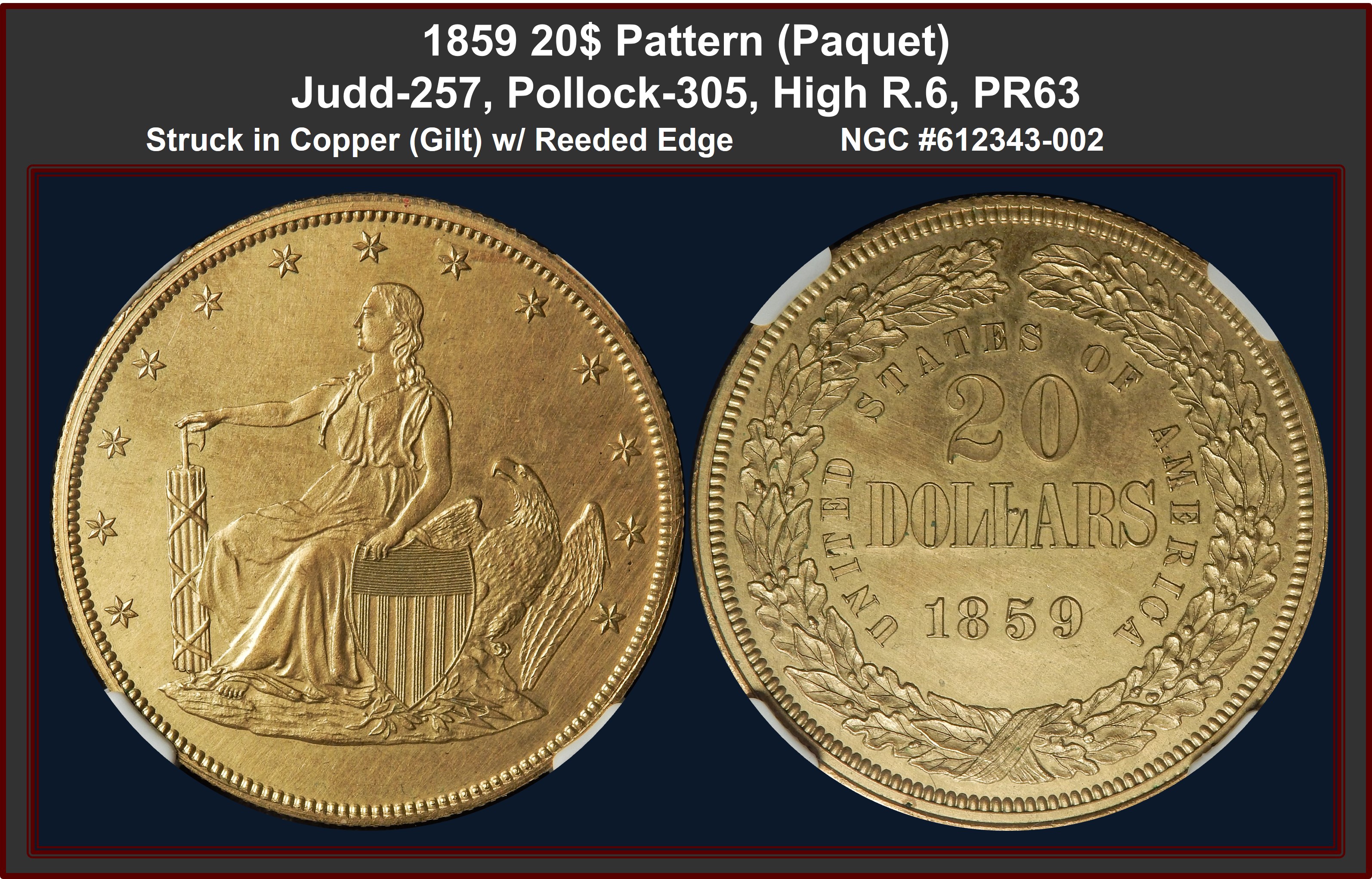
1859 $20
Judd-257, Pollock-305
Rarity: High R.6, PR63 Gilt
Struck in Copper and Gilt with Reeded Edge
Obverse: A seated figure of Liberty faces left on the obverse supporting a fasces with her right hand and a shield with her left. An eagle is standing behind the shield. 13 stars around the figure
Reverse: The denomination 20 DOLLARS, the date, 1859, and the legend UNITED STATES OF AMERICA are within a heavy oak and laurel wreath.
Comment:
Both obverse and reverse designs were created by Anthony Paquet. About 20 or so pieces are believed to exist, an undetermined number of which have been gilt.
Of the pattern gold coins of the 19th century, this is one has a very distinctive design. Most would say it has no counterpart among regular-issue gold coins. Moreover, it is one of relatively few pieces attributed to the hand of Anthony C. Paquet, who in 1859 had been a full time Mint employee for only two years.
The gilt finish is intact over both sides and the fields show moderate reflectivity. Sharply detailed.
Provenance/Appearances:
From Heritage Jan 2022 FUN Signature® Auction - Orlando FUN / Lot #4268; Prior: The Collection of William Rau / Central States Signature (Heritage, 4/2018) /Lot #4485; Stacks Sept 2000 /Lot 1331
|

|
|
View Coin
| J-263 20$ |
United States
|
$20 1859 J-263
|
PCGS PF 61 Brown
|

1859 $20
Judd-263, Pollock-312
Rarity: R.8, PR61 BN
Ex: Bass - Simpson
Plate Coin in Judd's 8th addition Reference Guide
Struck in Copper with Reeded Edge
Obverse/ Reverse:
Struck from the regular reeded edge dies for the 1859 Type One double eagle
Comment:
Struck from the regular issue dies of the year, here with 1 in LIBERTY from an 1 punch, rather than from the corrected L punch, as used 1850-1858. Upper loop of 8 in date noticeably repunched within.
Only three examples of Judd-263 are known, per the USPatterns.com website, and one of those is in the Byron Reed specimen in the Durham Western Heritage Museum, presently unavailable to collectors. The other is confirmed as:��the Metzger (H. Chapman 2/1909), Zabriskie (H. Chapman 6/1909), E. Adams, Simpson-Heritage 2/21 - PCGS62BN specimen.
The 1859 Pattern twenties with the Paquet reverse were also struck in copper, and Judd-263 may have been coined at the same time for the purpose of comparison.
The present sharply struck piece displays powder-blue and mahogany-brown toning. Minor spots near stars 4, 6, and 7 provide identifiers, and the obverse has a few tiny scattered marks.
Technical Aspects: Weight: 297.7 grains. Diameter. 34.0 mm. Die alignment: 180° per 1999 Bass sale Catalog.
Video Description by Heritage
Video J-263
Provenance/Appearances:
From The Atherton Collection of U.S. Pattern Coins. Heritage May 2023 CSNS Signature® Auction / Lot #3379, Priors:
- Bob R. Simpson Collection, Part II (Heritage, 11/2020), /Lot #3121,
- Southern Collection
- Pevehouse & Davis Collections (American Numismatic Rarities, 10/2004), /Lot #1057 (as NGC60BN);
- Harry W. Bass, Jr. Foundation; Harry W. Bass, Jr. Collection, Part I (Bowers and Merena, 5/1999), /Lot #1404 (PCGS AU58); were he purchased this from Max Draisner, 8/1973
USpattern.com makes the following observation: Woodin displayed one of these pieces at the 1914 ANS exhibit which went to Newcomer, but it is not known if Adams bought this specimen for him or the other piece. One of these appeared in E. Cogan's 5/1860 & 3/1862 sales
|

|
|
View Coin
| |
United States
|
$2.5 1860 J-270
|
PCGS PF 64 Brown
|

1860 P$2 1/2 Quarter Eagle,
Judd-270, Pollock-318,
High R.7, PR64 BN
Ex: Eliasberg/Clapp
Struck in Copper with Reeded Edge
Obverse: The obverse resembles the issued 1865 three cent nickel.
Heritage Obverse Video View
Reverse: The reverse shows the denomination, 2 ½ DOLLARS, and the date within a laurel wreath. UNITED STATES OF AMERICA and E PLURIBUS UNUM are absent.
Heritage Reverse Video View
Comment:
A muling of dies having different dates, 1857 and 1860 as illustrated! The obverse is dated 1857 and is similar in style to that later adopted for the nickel three-cent piece and was first used in 1857 for a pattern quarter eagle (a little-known fact to specialists in the nickel three-cent series). The reverse is dated 1860 and has the denomination and the date inscribed within a laurel wreath with prominent raised veins in the leaves.
The reason for striking this issue is unknown. Certainly, no quarter eagles with two different dates were contemplated. Perhaps it was a muling created for numismatists, but if so, only a few’ were made in an era in which larger numbers were usually made of such delicacies. In any event, the obverse die already had a history of muling (see note) by the time it was used again in 1860.
Sharply struck and lightly mirrored with rich mahogany-brown surfaces. Trivial toning spots are evident with hints of faded mint red.
Weight: 37.5 grains. Diameter: 0.700 inch.
Heritage Video Description
Provenance/Appearance:
From The Estate of Charles W. Montgomery, Heritage Nov 2023 Dallas / Lot #3276, Prior
- Ex: J.F. McCabe (S.H. and H. Chapman, 6/1905), lot 96;
- J.M. Clapp; Clapp Estate (Stack's, privately, 1942); Louis E. Eliasberg, Sr.;
- Eliasberg Estate (Bowers and Merena, 5/1996), lot 309;
- American Numismatic Rarities (12/2003), lot 320;
- Superior (5/2004), lot 2206;
- Bowers & Merena Jan 2005 (Rarities Sale) Lot #1412;
- Goldberg Auctions (5/2005), lot 702.
|

|
|
View Coin
| J-272 5$
Struck in copper on 10$ size Plancet |
United States
|
$5 1860 J-272
|
PCGS PF 63 Brown
|
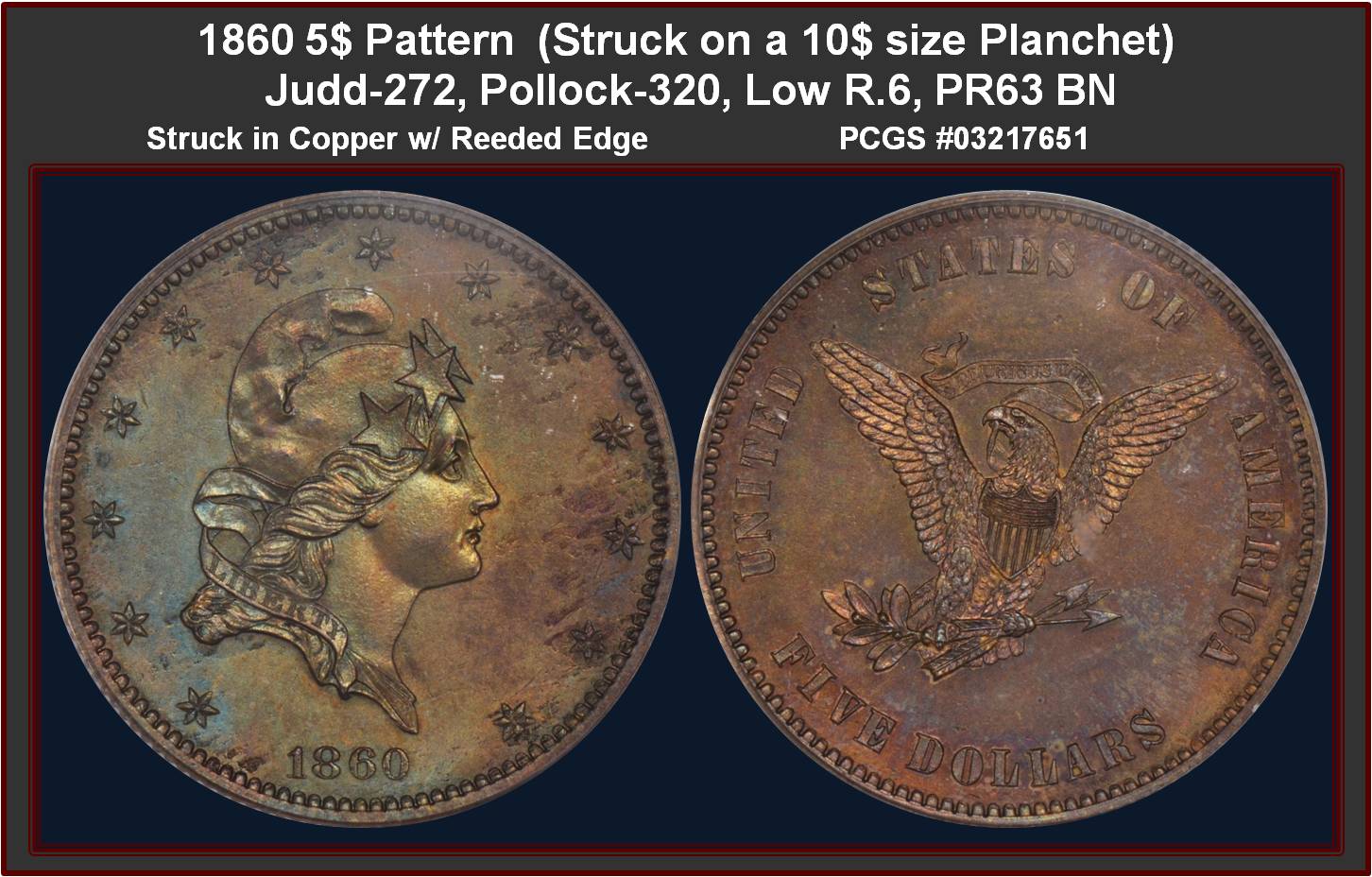
1860 $5
Judd-272, Pollock-320
Rarity: Low R.6, PR63 BN
Struck in copper with a reeded edge
Obverse: The obverse displays a right-facing bust of Liberty with three large stars on the cap and 13 stars around the perimeter. This is somewhat a familiar motif within the Standard Silver series and first used on Judd-271 and Judd-272. The date is noticeably small.
Reverse: Features a small eagle with a curved shield, clutching the banner bearing E PLURIBUS UNUM in its beak along with an olive branch and arrows in its claws. UNITED STATES OF AMERICA is above and circles the perimeter and FIVE DOLLARS is below.
Comment:
The piece was struck on an eagle-sized planchet as an anti-counterfeiting measure. Produced on thick and thin planchets, this is a thin-planchet variant. The surfaces are pleasing, toned in deeper autumn leaves coloration. Fully struck.
The diameter is remarkably large for a half eagle, resembling in size a coin of the $10 denomination. In 1860 it was ascertained at the Treasury of the United States in New York that U.S. $10 gold pieces were being sawed in half edgewise and hollowed out. The coins were then reassembled with a disk of platinum taking the place of the lost gold (platinum at the time had a lower value than gold). It was reasoned at the Mint that by increasing the diameter and reducing the thickness of the larger gold coins in circulation, this fraudulent alteration would become difficult if not impracticable. The Judd-272 $5 pattern was produced to illustrate the concept
Provenance/Appearance:
Private Sale Dec 2018 , Prior
-From The Collection of William Rau, Heritage April 2018 Signature Auction - Chicago / Lot #4933,
-Bowers and Merena 9/15/1993 The Tower Hill Collection /Lot #3100
|

|
|
View Coin
| J-285 10$
God Our Trust |
United States
|
$10 1861 J-285
|
PCGS PF 62 Brown
|

1862 $10 Ten Dollar
Judd-285, Pollock-340
Rarity: High R.7, PR62 BN High Date variation
Struck in copper with a reeded edge.
Obverse: The regular ten dollar dies for 1861.
Reverse: Similar to the regular dies design but with the addition of the motto GOD OUR TRUST on a scroll above the eagle.
Comment:
This a high date, rounded bun Pollock subvariety. Only a half-dozen or so pieces are believed known. This important example is toned in rich, rust-red shades with gray-tinged accents in the open fields. All features are boldly, if not sharply struck, and no mentionable abrasions.
A nice coin for the grade, and a rare pattern issue.
Longacre on "GOD Our Trust" inscription:
“ … The most appropriate place for such a motto, is found in connection with the national inscription, which on all our large coins is on the reverse: the device of which is an eagle with the heraldic accompaniments appropriate to the arms of the union as adopted by law: dispensing ar present with the mtto (E Pluribus Unum) and the crest, except on the Double Eagle: The place of the crest offers the best position for the insertion of such a motto as is now required as on all of the other coins which are large enough to admit of such an addition – this place is now vacant – and a motto if sufficiently brief may be introduced with the least disturbance of the device as now arranged – and I have made a drawing of the reverse of the Double Eagle in outline to indicate such a modification of the crest as will present the motto however (which was the first suggestion) “Our Trust is in God” - I found on attempting to apply it to the Eagle and Half Dollar reverses – contained too many letters to insert in the place of the crest without crowding them too much for good taste: and therefore selected for greater brevity the words “God Our Trust”; which carries the same idea – in the form of expression according with heraldic usage ~ and probably as readily understood as the more explicit form of the other.
From the considerations before mentioned, I have confined my attention to the inscription of the motto, without changing the artistic portions of the present devices. It may not be amiss to be remark however that the smallest change of the permanent devices or legends on the face of the coin, required the making of new hubs for the dies on which it is to be placed.��A) I have struck this on reverse dies of the Eagle and Half Dollar, and impressions, in copper of the Eagle, and in silver of the Half Dollar are presented with these remarks which will serve to show the effect as proposed: This motto in the same letter can be placed on the four larger denominations.
Provenance/Appearances:
From Great Collections Feb 2023 ID # 1294768 priors: Heritage April 2018 CSNS Auction - Chicago / Lot #4935; ANA Signature (Heritage, 8/2001), lot 8323
|

|
|
View Coin
| J-287 10$
Struck in Copper Gilted |
United States
|
$10 1861 J-287 GILT
|
PCGS PF 63
|

1862 $10 Ten Dollar (Gilt)
Judd-287, Pollock-344
Rarity: High R.7, PR63 Gilt CAC Endorsed
Ex: Bass
Plate coin for type in Pollack’s Pattern reference Book fig. 160
Struck in copper and Gilted with a reeded edge.
Obverse: The regular ten dollar dies for 1861.
Reverse: Similar to the regular dies design but with the addition of the motto GOD OUR TRUST on a scroll above the eagle.
Comment:
The high date, rounded bun Pollock subvariety. With the 2nd 1 evenly centered between dentils and the truncation of liberty bust. About a half dozen of both the low date and high date varieties are known, per USPatterns.com.
This gilt copper representative enjoys rich yellow-gold color. A handful of small spots near star 11 and a few more on the reverse are the only obvious imperfections.
146.5 grains, 1.063’ dia , ~190 deg dies alignment
Provenance/Appearances:
From Heritage Aug 2023 ANA The Harry W. Bass, Jr. Core Collection, Part IV; Prior Ex: Gilhousen Collection (Superior Galleries, 2/1973), lot 1056.
|

|
|
View Coin
| J-297 G10$
Rev "GOD OUT TRUST" |
United States
|
$10 1862 J-297
|
PCGS PF 64 Brown
|

1862 $10 Ten Dollar
Judd-297, Pollock-355 (Low Date varity)
Rarity: High R.6, PR64 BN
Ex: Simpson.
Struck in copper with a reeded edge.
Obverse: The regular ten dollar dies for 1862.
Reverse: Similar to the regular dies design but with the addition of the motto GOD OUR TRUST on a scroll above the eagle.
Comment:
The low date, bulging bun Pollock subvariety. This is where the Date is Lower as the 2 is closer to the dentils than to the truncation of Liberty bust.
About a half dozen High Date examples are known in copper, compared to about a dozen Low Date pieces. Many of them have been gilted.
This near-Gem proof enjoys smooth surfaces and deep mahogany-brown color with a single spot between stars 11 and 12
Provenance:
Bob Simpson Pt3, Heritage Jan 2021 FUN Auction / Lot #3090
|

|
|
View Coin
| J-298 G10$ Bronzed
Rev "GOD OUT TRUST" on field |
United States
|
$10 1862 J-298 BRONZED
|
PCGS PF 65 Brown Brown
|

1862 $10 Ten Dollar
Judd-298 Bronzed, Pollock-357 (Low Date Varity)
Rarity: High R.6, PR65+ BN CAC endorsed
Ex: Simpson
Struck in copper with a reeded edge.
Obverse: The Liberty head type used to coin the regualr 1862 Half eagle
Reverse: Similar to the regualar issue type however the motto GOD OUR TRUST appears in plain letters over the eagle.
Comment:
The reverse die is rotated about 30 degrees clockwise. This is the slightly more available Low Date variety (Pollock-357) with the 2 closer to the dentils than to the truncation of Liberty’s bust. About a dozen pieces are thought to exist. The bronzed surfaces are deep mahogany-brown with the faintest steel accents. Strike definition is absolutely razor-sharp.
Provenance:
Private sale 4/21; Prior Bob Simpson Pt3, Heritage Jan 2021 FUN Auction / Lot #3091; Heritage June 2004 Long Beach Signature Sale / Lot #9574 (PR65 PCGS); Stacks-Bowers Galleries 11/14/2007 The Amherst & Waccabuc Collections /Lot #1144
|

|
|
View Coin
| J-350
10$G Struck in copper/Bronze
Rev: "GOD OUR TRUST" |
United States
|
$10 1863 J-350 BRONZED
|
NGC PF 64 BN
|

1863 $10 Ten Dollar
Judd-350, Pollock-422
Rarity: Low R.6, PR64 BN CAC Endorsed
Struck in copper & Bronze with a reeded edge.
Obverse: The regular ten dollar dies for 1863.
Reverse: Similar to the regular dies design but with the addition of the motto GOD OUR TRUST on a scroll above the eagle.
Comment:
The design elements are fully struck, and the surfaces are generally problem-free for the grade. While struck as a proof, the bronzing has subdued the reflective qualities in the fields.
Provenance/Appearances:
From David Lawrence 12/1/2021; Prior Heritage Aug 2011 Chicago Signature / Lot #5240
|

|
|
View Coin
| J-352 10$ |
United States
|
$10 1863 J-352
|
PCGS PF 64 Brown
|

1863 $10 Ten Dollar
Judd-352, Pollock-424
Rarity: Low R.6, PR64 BN Bronzed
Ex Simpson
Struck in copper & Bronze with a reeded edge.
Obverse: The regular ten dollar dies for 1863.
Reverse: Similar to the regular dies design but with the addition of the motto GOD OUR TRUST placed directly on the field above the eagle.
Comment:
About two dozen copper examples are known and most have been bronzed, as this piece has. As with all these bronzed pieces, the surfaces are uniformly dark brown with just a hint of underlying reddish color. The strike is complete in all areas.
George Eckfeldt's journal notes the following with regard to the copper examples: “Nov 17th 1863. Struck 20 sets of copper 10 dollar pieces "God is our Trust".”
Provenance/Appearances:
From The Atherton Collection of U.S. Pattern Coins, Heritage May 2023 CSNS Signature® Auction / Lot #4937 , prior Ex: Important Selections from the Bob. R. Simpson Collection, Part II / Dallas Signature (Heritage, 11/2020), lot 3131.
|

|
|
View Coin
| J-450 10$
Copper Transitional |
United States
|
$10 1865 J-450
|
PCGS PF 64 Red Brown
|

1865 $10 Ten Dollar,
Judd-450, Pollock-522,
Rarity: High R.6, PR64 RB
Struck in Copper with Reeded Edge
Obverse: The regular issue design
Reverse: The regular design later years but with the Motto added above th eeagle IN GOD WE TRUST
Comment:
A little more than a dozen examples of this pattern variety are known, and a few have been gilt to represent gold impressions of this die combination. The obverse displays mahogany color with hints of pale green and light orange. The reverse shows bright greenish-gold color with iridescent toning.
Like many others, these examples are sometimes called transition pattern issues, although they were likely not struck until 1869.
Provenance/Appearances:
From Heritage Feb 2023 Long Beach Expo / Lot #3415 priors,
- FUN Signature (Heritage, 1/2007), lot 1316
- Heritage Jun 2001 Long Beach / Lot #9461,
- Heritage Mar 2001/ Lot #1452 (PASSED)
- Heritage June 1987 Newport Beach, CA Sale Lot #4568
|

|
|
View Coin
| J-543 3$
ALUMINUM |
United States
|
$3 1866 J-543
|
PCGS PF 64
|

1866 $3 Three Dollar,
Judd-543, Pollock-608,
Rarity: High R.7, PR64
Struck in Nickel with Reeded Edge
Obverse/Reverse:
Regular dies of the 3$ Gold Piece
Comment:
An elusive regular dies trial striking after James B. Longacre's adopted design.
With no need for a three dollar gold piece struck in nickel, the half dozen or so pieces that are known were undoubtedly struck for collectors. USPatterns.com notes: "They appear to have been struck on whatever planchets were available. Pollock lists one of the Smithsonian examples at 54.2 grains which is from the same planchet stock used to strike many thin planchet 5 cent nickel patterns of that year. The Byron Reed coin is on an even thinner planchet, 39.5 grains, as opposed to the 36.6 listing in Pollock."
The silver-gray planchet of this piece, while almost totally free from post-minting disturbances, exhibits heavy pitting from die rust on the headdress and more subtle graininess near the base of the wreath and in intermittent areas over the balance of the coin.
Provenance/Appearance :
From The Estate of Charles W. Montgomery Heritage Nov 2023 Dallas / 3281; Prior Ex: Long Beach Signature (Heritage, 6/2004), lot 6419.
|

|
|
View Coin
| J-598 3$ (Silver) |
United States
|
3$ Gold 1867 J-598 H. Bass
|
PCGS PF 61
|

1867 $3 Three Dollars
Judd-598, Pollock-662,
Rarity R.8,( Only 2 Known) PR61
Ex: Woodin-Newcomer-Farouk-DiBello-Sieck and HARRY BASS
Struck in Silver with Reeded Edge
Obverse/Reverse: Each side features the regular three dollar design for the year.
Comment:
This is one of two examples known in silver, with the other being the Byron Reed coin in the Durham Museum.making this piece the only example of Judd-598 in private hands.
Interesting to note that the dies match those of the 1867 circulation die strikes, not those of the the proof dies, This is evidence by examining the date position on the reverse, which is somewhat higher and more to the right on the Proof coins vs the general dies and the wreath top ends touches each other on this piece while there is a gap on the Proof dies..
Silvery surfaces show elements of golden color, though hairlines limit the grade.
Uspattern.com has the pedigree as noted below, while Pollack in his reference has the Farouk as a separate listing. Considering this piece may had been cleaned and lacquered, this qualified it to be a Farouk piece as that was his typical treatment of coins in his collection combined with Dibello had collected many of Farouk patterns.
83.2 grains, diameter .806” , die alignment 180 deg
Provenance/Appearances:
From The Harry W. Bass, Jr. Core Collection, Part II. Heritage Jan 2023 Fun Lot # 9061 Priors:
- William H. Woodin; & Waldo C. Newcomer;
- King Farouk; Palace Collections of Egypt Sale (Sotheby's, 2/1954), lot 1807;
- Kreisberg & Schulman Feb 1960 / Lot # 2440
- Gaston DiBello Collection, Part II (Stack's, 5/1970), lot 480;
- William R. Sieck Collection (Bowers and Ruddy, 7/1981), lot 329.
|

|
|
View Coin
| J-604 20$ Copper |
United States
|
$20 1867 J-604
|
NGC PF 63 BN
|
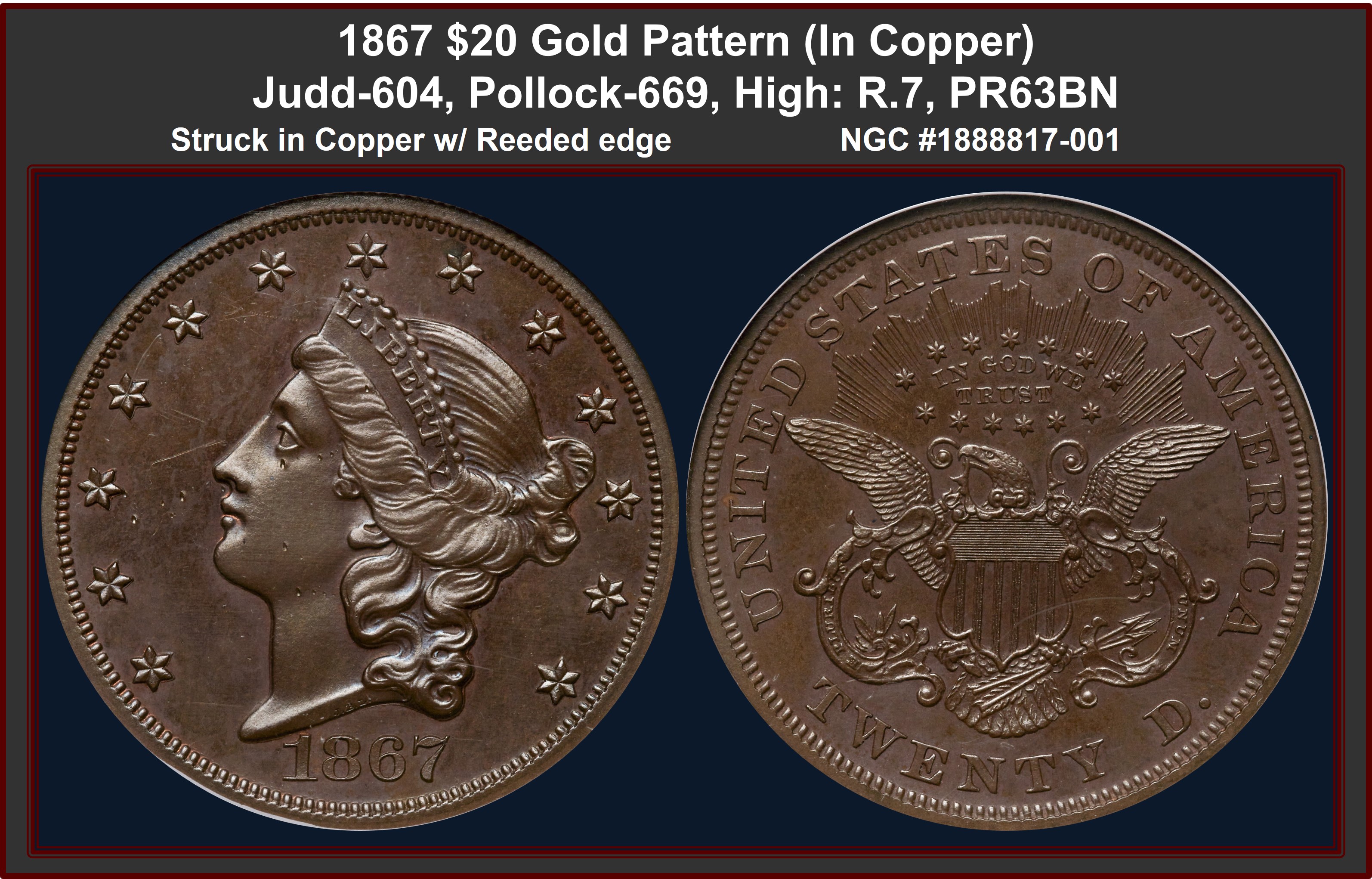
1867 $20 Twenty Dollar,
Judd-604, Pollock-669,
Rarity: High R.7, PR63 BN
Struck in copper with reeded edge
Obverse/ Reverse: Struck using the regular Double eagle dies of year but in copper
Comments:
The present piece is a deep mahogany-brown specimen and well struck and exhibits a nearly flawless reverse. The obverse has a few minuscule ticks on the cheek and left field, along with a thin line on the field near the nose
USPatterns.com states,that these were likely deliberately struck for sale to collectors as part of complete copper sets, about a half dozen are known.
Provenance/ Appearances:
From Heritage Jan 2023 FUN / Lot #4016 prior Stacks Jul 1985 (Auction 85) / Lot# 1838 A part of 6-piece set
|

|
|
View Coin
| J-653 1$ G
Struck in aluminum |
United States
|
G$1 1868 J-653
|
NGC PF 63
|

1868 $1 Gold Dollar
Judd-653, Pollock-726
Rarity: High R.7, PR63
Struck in Aluminum with Reeded edge
Obverse and Reverse:
The regular dies trial piece for the gold dollar.
Comment:
According to the USPatterns,com: "These were deliberately struck to show how easily aluminum coined ..." Only a half-dozen pieces are believed known today. Since aluminum is a malleable metal, the strike definition is complete throughout.
The surfaces are bright, and the only identifying imperfection is a planchet flaw on the reverse just left of the 1 in the denomination.
Provenance/Appearance:
From The Estate of Charles W. Montgomery, Part II, Heritage Dec 2023 Signature® Auction / Lot #3671 priors:
- John E Drew Collection Bowers & Merena Mar 1996 / Lot #2067
- Steve Ivy April 1977 (Trinity Sale) / Lot #1102;
- Steve Ivy Oct 1977 (Brazos sale) / Lot #102
|

|
|
View Coin
| |
United States
|
1868 2.5$ J-654 Pittman
|
PCGS PF 64
|

1868 $2 1/2 Quarter Eagle
Judd-654, Pollock-727
Rarity: Low R.7, PR64
Ex: Pittman
Struck in Aluminum with Reeded edge
Obverse and Reverse:
Regular dies trial issue for the quarter eagle.
Comment:
Cased sets of regular dies coinage struck in aluminum were sold to collectors in 1868 and 1869. About six to eight examples of this pattern issue are known today.
Very thin planchet, which is the reason for the low weight. The reverse has a trace of corrosion and some light hairlines. The obverse has a spot on the cheek to the left of the earlobe as well as a semi-circular cut on the truncation of the neck directly above the last 8 in the date. Full light gray brilliance appears on both sides of this piece; weakly struck at the denticles.
7.5 grains.
Provenance/Appearance:
From The Estate of Charles W. Montgomery, Heritage Nov 2023 Dallas / Lot #3282 Priors: Ex: 1958 ANA Sale (Abe Kosoff, 8/1958), lot 1607; John J. Pittman Collection (David Akers, 10/1997), lot 791; Superior Sept 1998 / Lot 1893; JJP purchased at Kosoff's 1958 ANA Convention sale / Lot #1607 for 65$
|

|
|
View Coin
| J-659 5$/25 Francs
Dual Denomination
Half eagle |
United States
|
$5 1868 J-659
|
PCGS PF 63
|
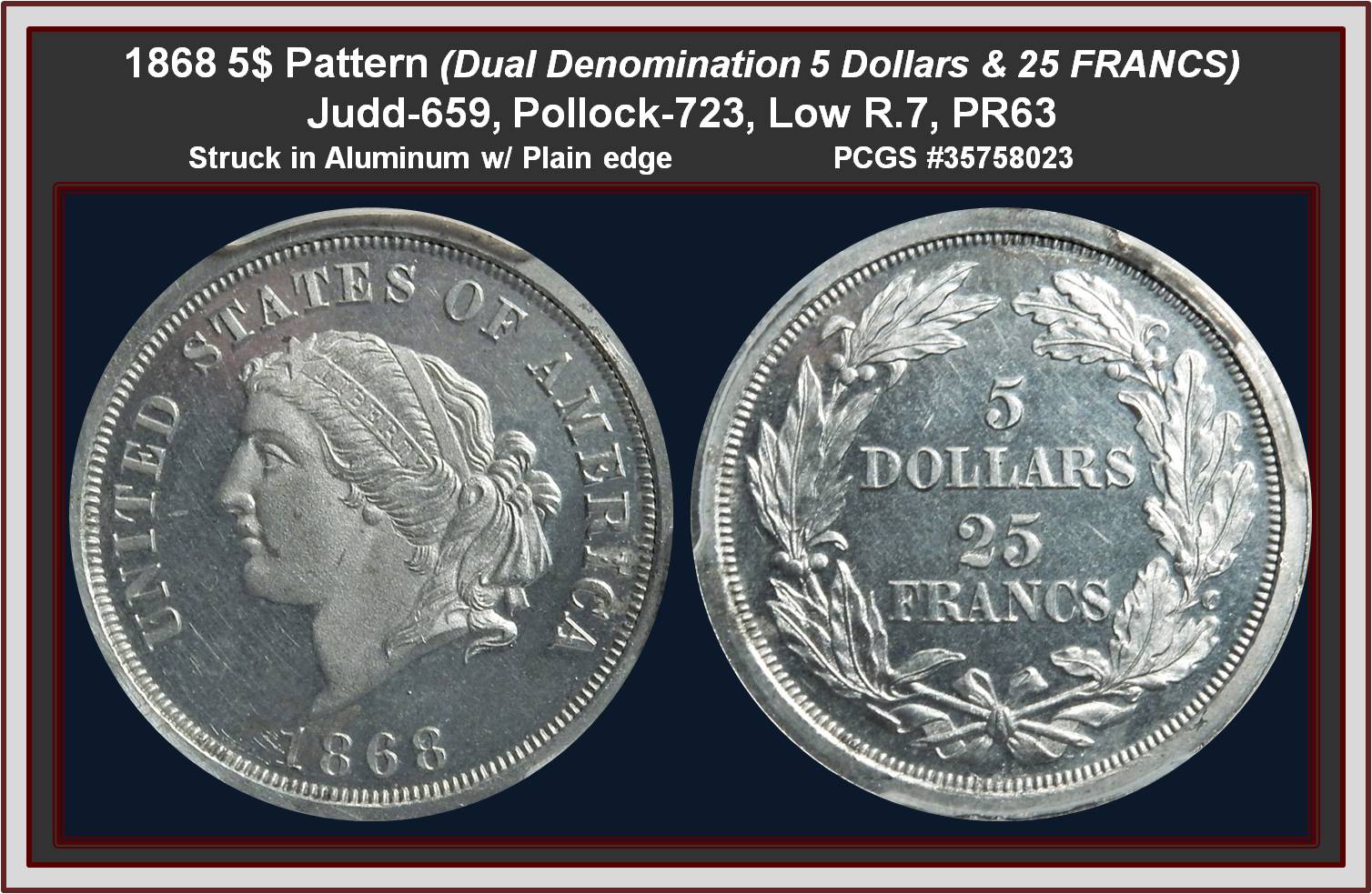
1868 5$ Dual Denomination Pattern $5-25 Francs
Judd-659, Pollock-732
Low R.7, PR63
Struck in aluminum with a plain edge
Obverse:
Anthony Paquet's design Bust of Liberty facing left with the legend UNITED STATES OF AMERICA around the date 1868 below. LIBERTY is inscribed on a ribbon that bounds her hair, and a single star is mounted on the ribbon.
Reverse:
The reverse is simply inscribed "5 / DOLLARS / 25 / FRANCS" in the center with a laurel and oak wreath surrounding. About a dozen examples are known with a similar number of reeded edge aluminum pieces known.
Comment:
This was Paquet’s response to the June 1867 international monetary convention in Paris that was proposed an international Gold standard for trade and the subsequent request in Congress for a creation of an international 5$ gold coin. Each country (except France ) was to adjust some standard on their coinage to establish a common coin and this piece would have weigh 124 -9/20 grains making it equal to the 25 franc piece.
This example is a well struck and the surfaces are bright with the frosted cameo appearance. The few specks of oxidation are seen on each side which may have limited the grade.
Provenance:
The Collection of William Rau. Heritage 2018 April 25 - 29 CSNS - Chicago / Lot #4990. Also appears to be from The Dr. Jon Kardatzke Collection part II June 2000 Ira and Larry Goldberge / Lot 1070 which also had a noted reference as The Madison Collection and from the Empire Coin Company
|

|
|
View Coin
| J-662
10$ Coronet Head
Copper |
United States
|
$10 1868 J-662
|
PCGS PF 64 Brown
|

1868 $10 Ten Dollar
Judd-662, Pollock-735
Rarity: Low R.7, PR64BN
Ex: Simpson
Struck in Copper with a reeded edge.
Obverse: The obverse has a large bust of Liberty facing left with thirteen stars around and the date below.
Reverse: A small eagle with upraised wings as the central motif, the motto on a scroll in the field above, and UNITED STATES OF AMERICA / TEN D. at the margin.
Comment:
Believed to be a Longacre design as the Head of Liberty is that used on the Nickel Three cents a used in 1865. About a dozen examples of this design are known with many being gilt. Light brown and iridescent fields accompany the rich chocolate-brown devices of this Choice proof.
Provenance/Appearances:
From The Bob R. Simpson Collection Heritage Jan 2024 FUN / Lot #5265
Prior: Bowers & Merena Nov 1995 (Rogers Fred Collections) Lot #2347: Obtained from Julian Leidman.
|

|
|
View Coin
| J-663
10$ Coronet Head
Aluminum |
United States
|
$10 1868 J-663
|
PCGS PF 64
|
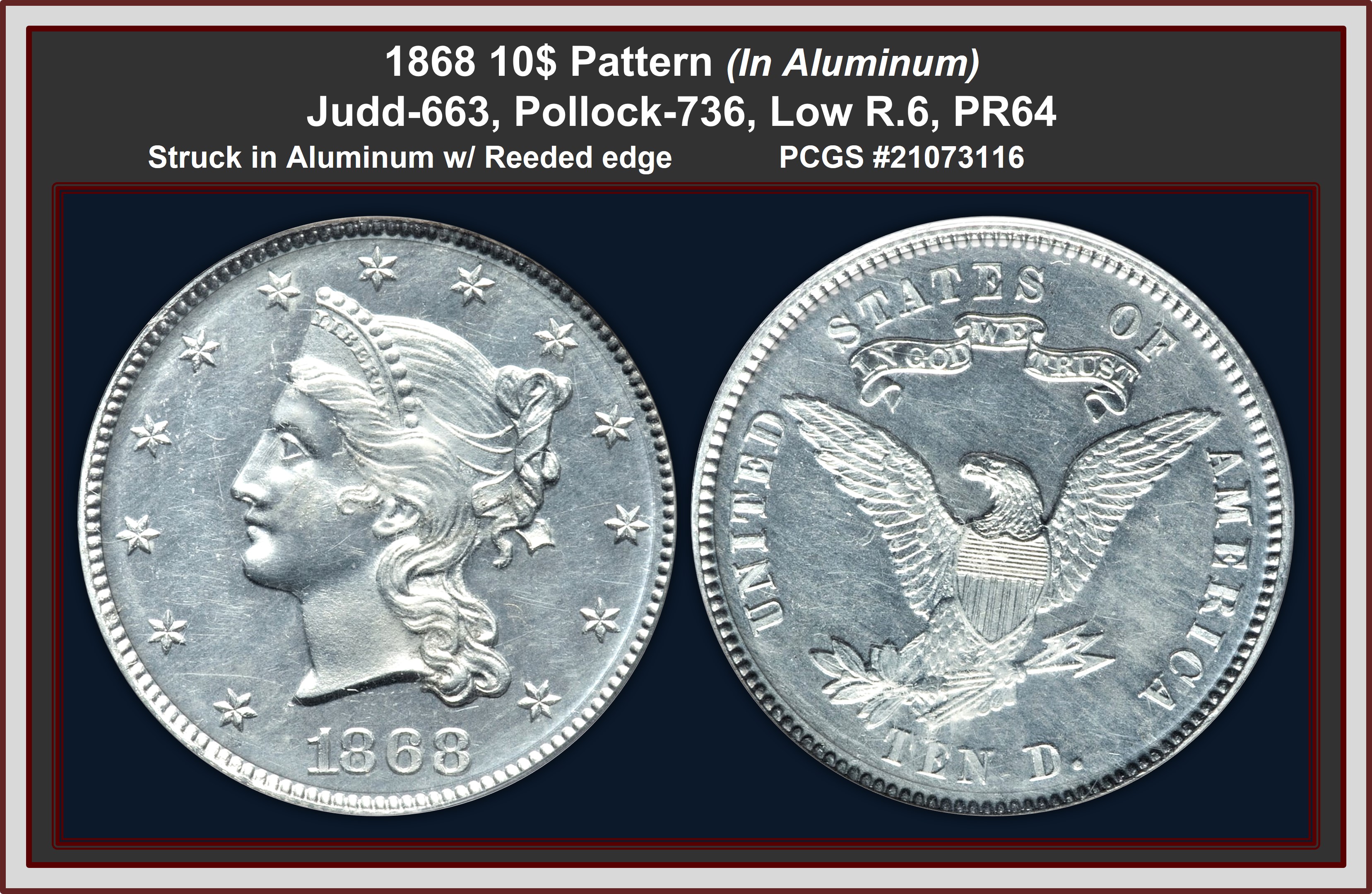
1868 $10 Ten Dollar
Judd-663, Pollock-736
Rarity: Low R.6, PR64
Struck in aluminum with a reeded edge.
Obverse: The obverse has a large bust of Liberty facing left with thirteen stars around and the date below.
Reverse: A small eagle with upraised wings as the central motif, the motto on a scroll in the field above, and UNITED STATES OF AMERICA / TEN D. at the margin.
Comment: Believed to be a Longacre design as the Head of Liberty is that used on the Nickel Three cents a used in 1865. About a dozen aluminum examples of this design combination are known. The surfaces are bright throughout and the fields display deep reflectivity. A lamination, resembling a smudge, is seen on the face of Liberty, which undoubtedly accounts for the grade. Also there is a very high wire rim on obverse.
Technical Details: 39.3 grains. Diameter: 1.067 inches. Die alignment: 180°.
Provenance/Appearances:
From The Pacific Rim Collection, Heritage Nov 2021 Signature® Auction / Lot #3482; Prior
- FROM THE STEVEN COOK COLLECTION, PART 2 Legend’s Jul 2018 The Regency Auction 27 / Lot #540;
- Stacks March 2014 Baltimore / Lot #6139;
- Heritage Dec 2013 Signature Auction - Houston / Lot #3941;
- Heritage Mar 2002 Internet Auction / Lot #15534;
- Bowers and Merena March 1993 / Lot #2078 (PF63/65) ($3080)
|

|
|
View Coin
| J-664 10$
Struck in Aluminum |
United States
|
$10 1868 J-664
|
PCGS PF 64
|
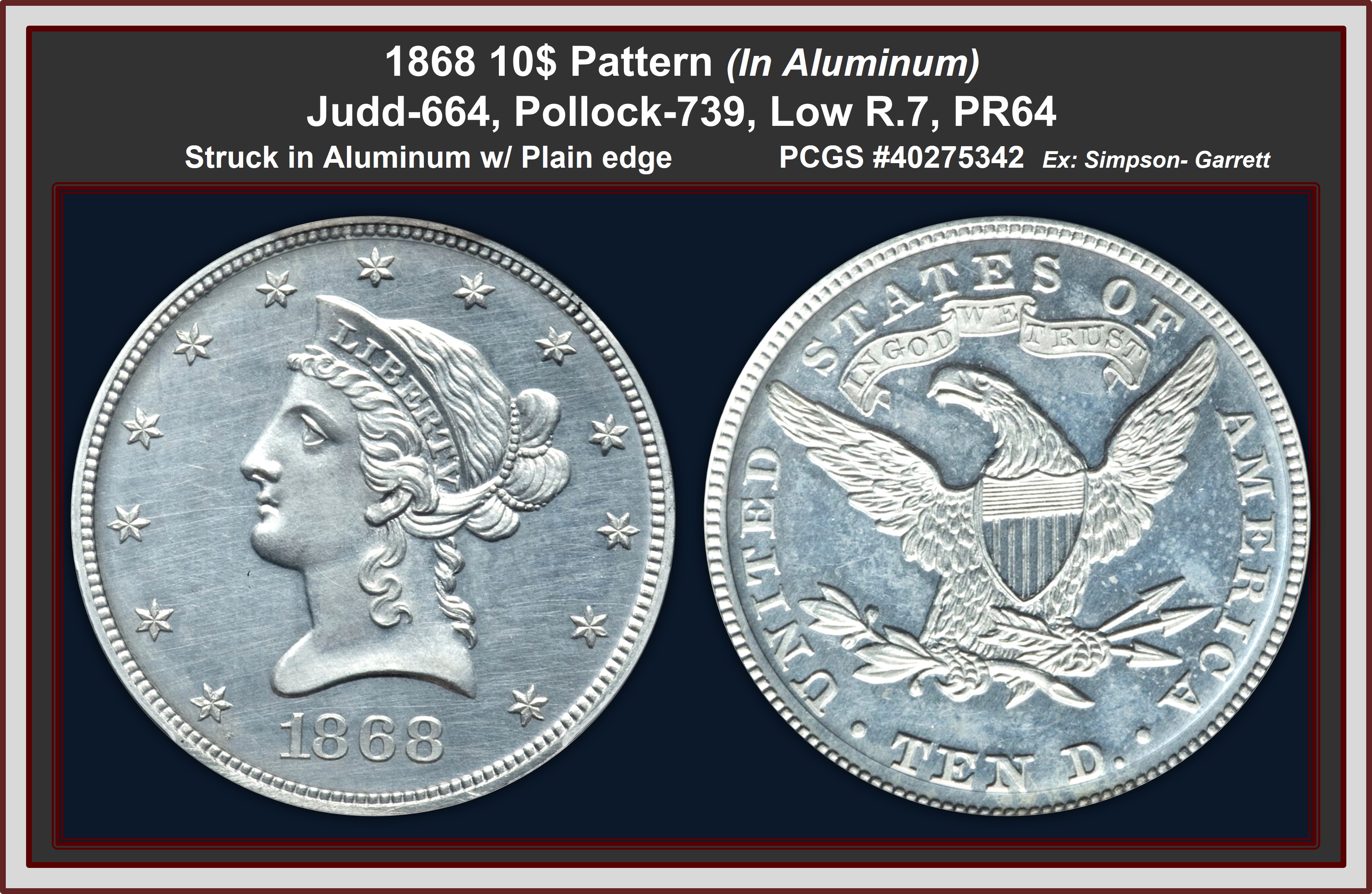
1868 $10 Ten Dollars
Judd-664, Pollock-739
Rarity: High R.7, PR64
Ex: Garrett-Simpson.
Struck in aluminum with a reeded edge
Obverse/Reverse: The design is identical to the regular-issue Liberty Head eagle for the year.
Comment:
This off-metal pattern was issued and sold to collectors as part of a complete set of aluminum coinage. One such set formed part of the Garrett Collection. Although the Garrett pedigree is listed on the holder, this piece does not match the Garrett example that Heritage offered previously. It is a rarity nonetheless, however, and one of only six or so pieces known.
Fully struck from polished dies, this aluminum ten dollar is brilliant and partially contrasted.
Heritage Auctions questions the PCGS Label reference to the Garrett Collection ... however in comparing photos to the Superior Oct 1989 (Jascha Heifetz Collection Sale) lot #3283 there appears to be a couple of rim diagnostics that are similar. That set claims pedigree as .Previously from Bowers and Ruddy's Garrett Sale 1 , November 1979, Lot 396, earlier from Sampson's sale, held February 16-17, 1882, conducted by Bang's & Co
Provenance/Appearance:
From the Bob Simpson Collection Heritage Feb 2021 Signature Auction / Lot #3208; possible priors:
- Superior Oct 1989 (Jascha Heifetz Collection Sale) lot #3283;
= Bowers and Ruddy's Garrett Sale 1 , November 1979, Lot 396, earlier from
- Sampson's sale, held February 16-17, 1882, conducted by Bang's & Co
|

|
|
View Coin
| J-779 G10$ |
United States
|
$10 1869 J-779
|
PCGS PF 65 Brown
|

1869 $10 Eagle In Copper
Judd-779, Pollock-864
High R.7, CAC Endorsed.
EX Bob Simpson Collection
Plate Coin Judd 10th edition
Struck in copper with a reeded edge
Obverse: The figure of Liberty facing left and sporting a coronet inscribed Liberty, but with hair down past her neckline and 13 stars surrounding with date below, This is similar but with subtle differences, to the regular-issue three cent nickel. This is the Date Right variety .
Reverse: The reverse is the regular-issue eagle die of the year. ..
Comment:
This is the "Date Right" die variety with leftmost flag point atop the 1 noticeably right of the forward bust tip. The date is about centered between the rim and bust tip. The "Date Left" variety shows those two points aligned, and the date is lower toward the rim. The obverse design is a posthumous one for the year, given that designer James B. Longacre died on January 1. The die was previously used on the Judd-661/3 patterns of 1868 during his lifetime
The present Gem Brown proof shows a pleasing dappled texture, deep reddish-brown with lighter gray and olive highlights scattered throughout. Heritage commented that they believe only three or four exist of this variety in both variants. This piece is the Judd plate coin in the 10th edition.
Provenance:
- From Bob Simpson Collection, Heritage Nov. 2020 / Lot #3174 Priors:
- A. Kosoff, 1962 Illustrated History Lot 370;
- ANR Jul 2003 Auction catalogue of American Numismatic Rarities / Lot 1067 ($12,500),
- Bowers & Merena Jan 1997 (Rarities Sale) /Lot #492 ;
|

|
|
View Coin
| J-1029 G3$
Struck In Copper |
United States
|
$3 1870 J-1029
|
PCGS PF 63 Brown
|

1870 3$G In Copper
Judd- 1029, Pollock P-1164
Rarity: High R.7 PR63BN, (3- 7 Pieces)
.
Struck in copper with a reeded edge.
Obverse/Reverse: The regular dies used to coin three dollar gold pieces in 1870 but stuck in copper
Comment:
Saul Teichman writes that about a half dozen examples are known.
Violet and blue tones complement medium brown surfaces. This Select three dollar dies trial is flashy and appealing with a singular lint mark on the cheek.
These were mostly struck for collectors as part of off metal sets.
Provenance/Appearances:
Private sale June 2020; Prior From The Collection of William Rau, Heritage April 2018 CSNS Signature Auction - Chicago / Lot #5076
|

|
|
View Coin
| J-1161 G1$
Struck in Copper |
United States
|
G$1 1871 J-1161
|
PCGS PF 65 Brown
|
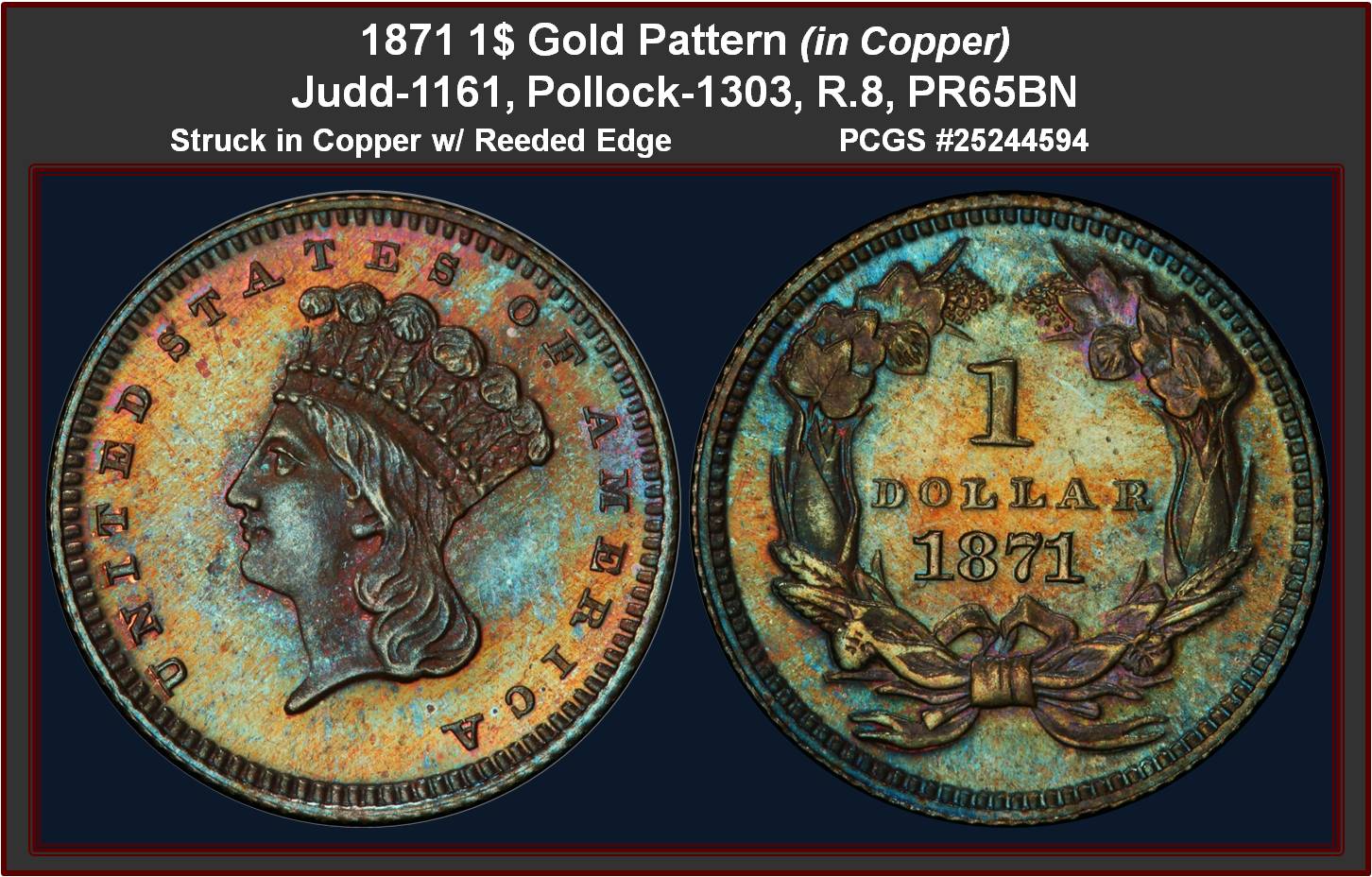
1871 Pattern Gold Dollar.
Judd-1161, Pollock-1303.
Rarity: High R.7 -8 . PF65BN
Struck in Copper with reeded Edge.
Design: A regular die trial piece of the Type III gold dollar design as adopted in 1856 and utilized for this denomination through 1889 but struck in copper. US Patterns highlight that trial strikes may not be a correct description and believe they were struck for collectors
Comment:
This wonderfully original specimen exhibits iridescent reddish-gold, apricot and powder blue undertones to dominant copper-rose patina. Watery semi-reflective fields support smartly impressed, fully struck devices.
An extremely rare piece by even the strictest standards.
It is noteworthy that both the copper and aluminum examples of this issue show identical flaws, one small low area before Liberty's chin, another below and right of her headdress, from grease or something similar adhering to the obverse die
the website uspatterns.com estimates that only a half dozen or so examples of Judd-1161 are extant.
Provenance:
Stacks August 2019 ANA U.S. Coins Auction Rosemont, IL / Lot 3409
This appears to be the same piece ( comparing photos) to the Stacks 6/16/2010 - C. B. Slade, Jr. Estate Auction where STACKS presumed the Provenance as below: That piece was in an NGC holder
"... This lovely coin, as well as the following two lots, have clearly been together since no later than 1974 (the time of the Pine Tree Auction sale cited below), and may in all probability have been together since before the sale of the King Farouk Collection in 1954. The family of the current consignor bought these three coins in one lot as offered in the Oscar J. Pearl Collection Sale in 1979....
From the Oscar J. Pearl Collection (Bowers and Ruddy, June 28, 1979. Lot 1383); earlier from the Greater New York Numismatic Convention Sale (Paramount, April 29, 1977, Lot 168); earlier from the First Walter Breen Gold Sale (Pine Tree Auctions, March 4, 1974, Lot 434); also almost certainly ex Palace Collection-King Farouk (Sotheby's, February 1954. Lot 1865) ... "
,
|

|
|
View Coin
| J-1164 G2.5$
Struck in Copper |
United States
|
$2.5 1871 J-1164
|
PCGS PF 65 Red Brown
|
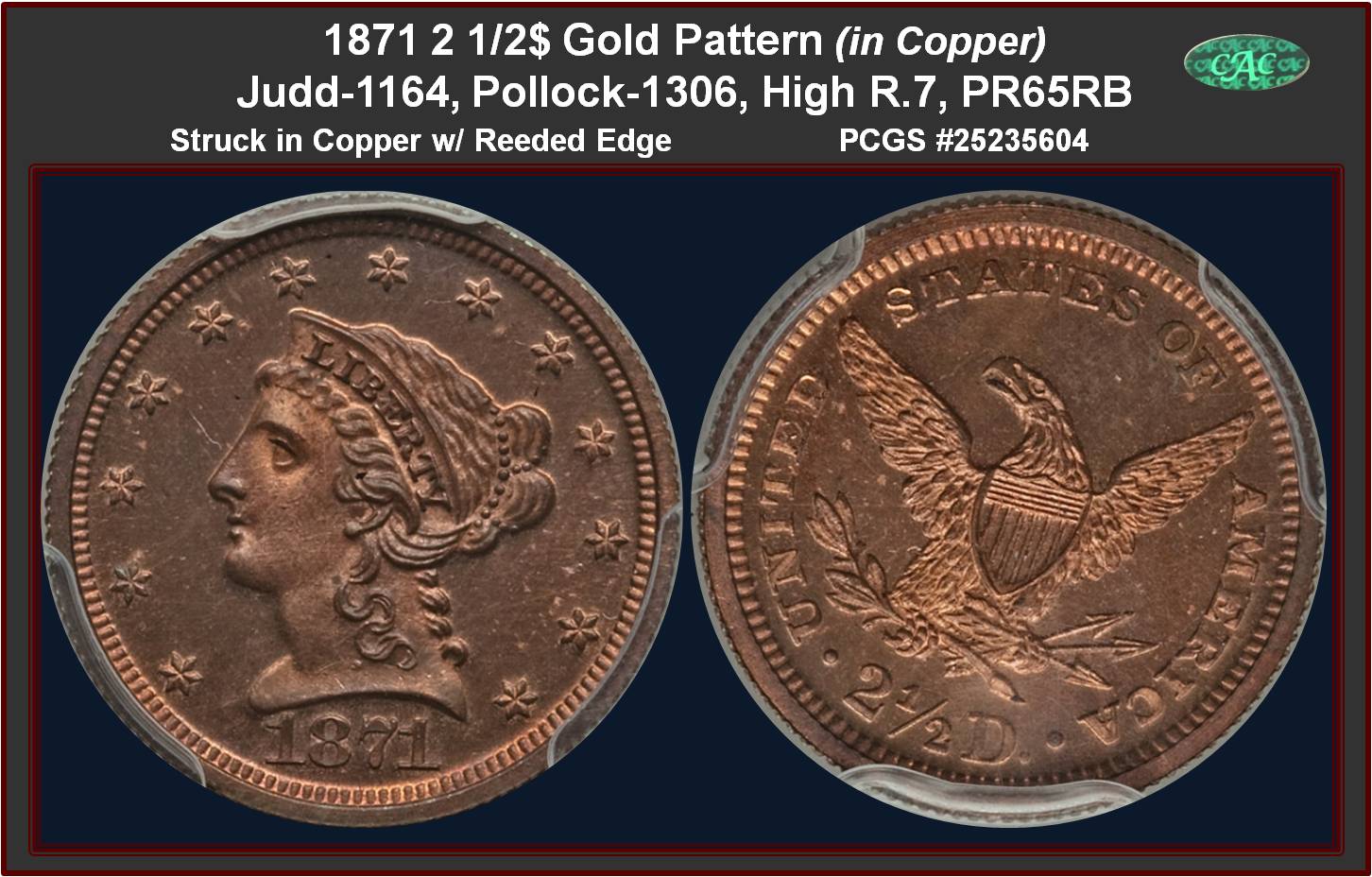
1871 Quarter Eagle In Copper
Judd-1164 Pollock P-1306
Rarity:High R.7, (3-7 Extant pieces) Likely only 4 pieces known; PR65RB CAC Endorsed
Struck in Copper with reeded Edge
Design: The regular dies for the 1871 Liberty quarter eagle, struck in copper.
Comments:
An incredible Premium Gem proof with a cameo contrast, and essentially red surfaces, only a hint of light brown toning show only slight brown toning acquired over the years appears on the design elements, splashes of pale violet patina. A boldly detailed, glittering proof that is probably the finest known example of Judd-1164. Interesting that in 2009 this was a full RB Cameo but crossed over to PCGS now only a 65 RB yet with a CAC endorsement
In the 1860s and 1870s, the Philadelphia Mint served as an active coin dealer, with the legal ability to create their own inventory, unlike private dealers. Sometimes called dies trial pieces, the copper and aluminum strikes from regular-design gold dies were most likely issued for collectors. The present piece has considerable field-to-device contrast with mostly brilliant red surfaces that show only slight brown toning acquired over the years
The current offering was part of a small group of U.S. gold patterns offered in the T. Henry Allen sale by Stack's in February 1977. It was described by that cataloger as "proof, almost full mint color. Rarely seen in this lovely state of preservation." It would have been more accurate to write, "rarely seen at all.. Heritage stated that they have records of three examples of the variety, two in copper and one gilt.
Provenance/Appearances:
From The Indian Rocks Collection, Heritage April 2016 CSNS – Chicago / Lot #4892 PCGS65RB; Prior as NGC66RB’s
Heritage Sept 2014 Long Beach / Lot #3579
Heritage Jan 2011 FUN / Lot #5372
The Lemus Collection, Queller Family Collection Part Two. Heritage Jan 2009 FUN - Orlando / Lot #1820 [in NGC PR66 RB CAM Holder]
T. Henry Allen Collection (Stack's, 2/1977), lot #1137;
Census. per Heritage
1. T. Henry Allen Collection (Stack's, 2/1977), lot 1137; Queller Collection. The present specimen.
2. Superior (2/1997), lot 2665; Stack's (10/1997), lot 955; Superior (9/1998), lot 1894; Bowers and Merena (9/2001, sold 11/2001), lot 178; Heritage (1/2007), lot 1475. PR63 Red and Brown PCGS.
3. Harry X Boosel (Rarcoa, 4/1972), lot 1131; Harry W. Bass, Jr. (Bowers and Merena, 5/1999), lot 1336. PR63 Gilt.
Other Appearances. Two other citations may be included in those above, or they might be additional examples:
A. Pine Tree (3/1974), lot 434; Paramount (4/1977), lot 171. This is either number 2 above, or a new example.
B. King Farouk; Palace Collections of Egypt (Sotheby's, 2/1954), lot 1864. This could be the same as any of the above.
|

|
|
View Coin
| J-1238 3$
STRUCK IN COPPER |
United States
|
$3 1872 J-1238
|
PCGS PF 64 Red Brown
|

1872 $3 Three Dollar,
Judd-1238, Pollock-1380,
Rarity: High R.7, PR64RB, CAC Endorsed
Struck in copper with a reeded edge
Obverse/ Reverse: Struck using regular regular-issue 1872 three dollar dies
Comment:
A stunning virtually GEM quality $3 die trial struck in copper with a reeded edge.. Sets of off-metal strikes were sold to VIP collectors and important officials in the 1860s to the early 1880s, and not a "die trial" as listed in the Judd reference.
Flashy mirrored fields gleam with a sensational brilliance when the light hits the surfaces. Purely original surfaces show off a wealth of original RED color that has just begun to "mellow" softly with an iridescent overlay of violet and orange-brown. The toning pattern of this GEM is clear enough to plate match to the sales listed below. The strike is crisp and full, the surfaces are incredibly clean and free of all but the tiniest of toning spots. The eye appeal is SUPERB!
Provenance/ Appearances:
From Legends Dec 2022 Auction 56 Lot #379, Priors:
- New England Rare Coin Auctions' 1979 ANA Auction, August 1979, Lot #1331; (as NGC64RB 219963-015)
- Jascha Heifetz Collection Sale, Superior, October 1989, Lot #3366
|

|
|
View Coin
| J-1241 5$
Amazonian In copper |
United States
|
$5 1872 J-1241
|
PCGS PF 63 Brown
|

1872 $5 Amazonian Five Dollar,
Judd-1241, Pollock-1383
Rarity:Low R.7, PR63 Brown
Ex: Simpson.
Struck in copper with a reeded edge.
Obverse: It features a head of Liberty facing left wearing a Phrygian headcap with the headband inscribed LIBERTY and her hair flowing from underneath. There are 13 stars surrounding the bust and date is below,.
Reverse: Barber's standing spread wing eagle with one talon holding 3 arrows and the other is supporting a shield with a scroll draped over with IN GOD WE TRUST inscribed on it. UNITED STATES OF AMERICA wraps around the perimeter above and “FIVE DOL. beneath
Comment:
William Barber's so-called Amazonian patterns are one of the most famous of all pattern designs, certainly the best known of the "named" series of patterns. Judd-1241 represents the most accessible version of the Amazonian five dollar with reportedly more than a dozen pieces known. The design represents the only uniform design ever made for all six gold denominations.
The gold Amazonian five dollar is unique, and only three examples are known in aluminum. This piece is a select proof features a copper-orange obverse and a deeper brown reverse with blue and violet colors appearing on each side.
Interesting to note that Saul Tiechman also believes the name “ Amazonian” may have originated with the 1890 (2/26/1890 ) New York Stamp & Coin company sale of Parmelee's coins
Lot 231 “1872 Barber's set. Dollar, Half, and Quarter Dol.: Amazonian figure of Liberty seated l. caressing an eagle, and resting on shield and sword with her l. arm: stars around border. Rx defiant eagle clasps three arrows and supports a shield labelled IN GOD WE TRUST: values below: silver: proofs: very rare; 3 pcs." The lot realized $13.50.
New York Stamp & Coin company was the same cataloger (April 1891) that coined the term “Wash-lady” for that series of Barber designs but in that case the description included ” …with enormous head of hair, held together by nothing visible …” which offered some insight in the nickname.
While the "Silver" seated liberty series was labelled "Amazonian" I do not know when the 6 piece Liberty Bust gold series of that year was nicknamed Amazonian. In the same catalogs NY Coin and Stamp did not use "Amazonian" as the descriptor rather just described the pieces as "profile of Liberty L. with Phrygian Cap: "
While there is no such additional description in the sale catalog for Amazonian it may have been been given the name as Liberty's has a warlike appearance that can remind one of the mythological female Amazonian warrior - that may not realy be a myth.
Looking the the The British Museum site was a famous sculpture 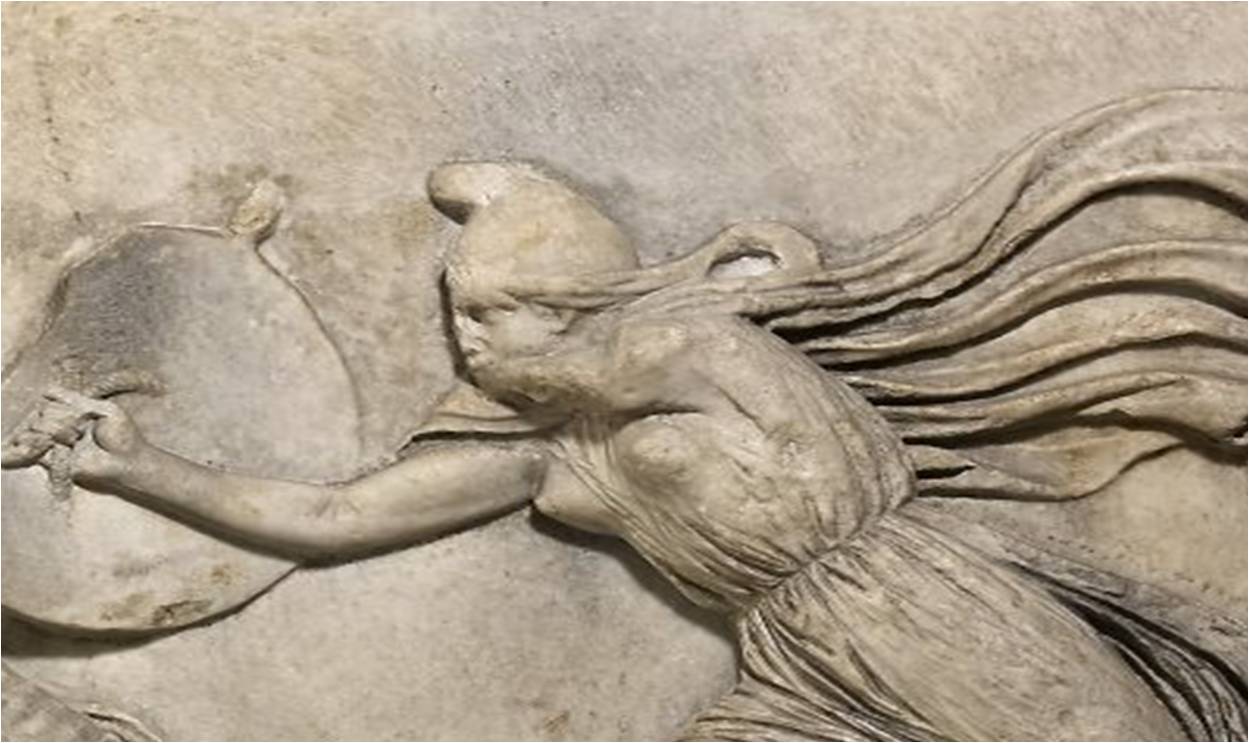
… Boudicca was one furious woman. Roman sources tell us that to intimidate this native Briton and the Iceni tribe of whom she was leader, ... The Romans violated her 2 daughters and in the heat of Boudicca’s anger, the humiliated queen strategized her rage and persuaded others to join her to try to push Rome out of Britannia...."
"... The same applies when it comes to the Amazons. Although they have been judged through time to be a quasi-mythical race of warrior women – archaeological and historical research now suggests these were real, flesh-and-blood female fighters from the tribes of Scythia and Sarmatia. …" [extracted from a blog by THE BRITISH MUSEUM]
There is archaeological evidence that show that a large percentage of excavated Sarmatian military burials include armed Sarmatian women, and that they occupy central positions in the grave and are buried with objects that indicate that they were rich and powerful.
Provenance:
Ex: Bob Simpson Heritage Aug 2021 ANA WFOM Auction / Lot #3175; Prior
- American Numismatic Rarities Jan 2006 ,The Robert Michael Prescott Collection / Lot 928 (as PR63 BN NGC;
- Believe also to be the Superior Feb 2000 Pre-Long Beach Sale of United States Coinage /Lot #882 (NGC 63 BN Again) ($3450)
- Bowers & Merena Mar 1999 (Voigt & Dr. Wallace Lee Collections) / Lot #58 (NGC 63BN Pass),
- Akers Oct 1997 (John Jay Pittman Collection: Part 1)/ Lot 802;
JPP Purchased for $205 from Empire Coin Co. on 8/9/61. Ex. Lenox Lohr Collection, Prior King Farouk
|

|
|
View Coin
| J-1243 G5$
Struck in Copper |
United States
|
$5 1872 J-1243
|
PCGS PF 64 Brown
|
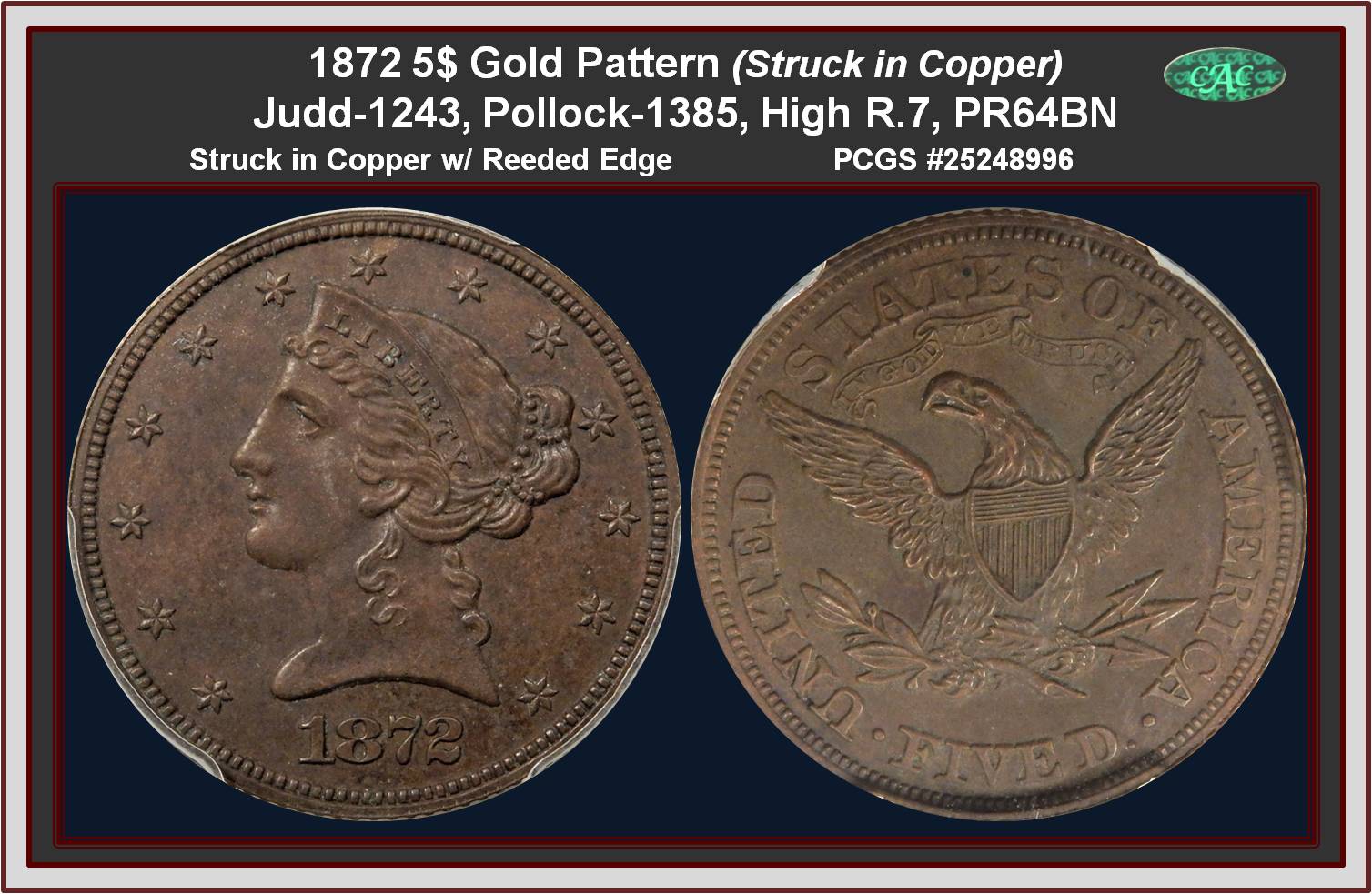
1872 Pattern Liberty Half Eagle.
Judd-1243, Pollock-1385
Rarity: High R.7 PR64BN CAC Endorsed
Stuck in Copper with Reeded Edge.
Obverse / Reverse: Regular dies for the 1872 Liberty half eagle but struck in copper
Comment:
Dominant reddish-brown obverse toning yields to somewhat dusky, sandy brown toning on the reverse. Both sides are equally smooth as far as freedom from contact marks is concerned, although a trace of extremely light, very faint surface build up in the protected areas around and among the devices.
The strike is as sharp and complete as one should expect given the care with which off-metal impressions such as this were produced in the Philadelphia Mint of the late 19th century.
The uspatterns.com website tells us: "Although these are described as regular die trial pieces in the standard references, it is more likely that the off-metal 'trials' of this year were deliberately struck for sale to collectors. Examples were struck in copper and aluminum (J1244) with only three or four of each believed to exist." An attractive and original pattern sure to appeal to Liberty half eagle specialists.
This Judd is a extremely rare piece an since 1972 only 3 unique pieces have cross the auctions as far as I can tell.
Provenance/Appearances:
Stack's & Bowers, Mar. 2019 Baltimore Auction /Lot 1210 Prior from:
- Samuel J. Berngard Collection, Stacks Bowers March 2012 Baltimore (Rarity Night) / Lot #4214 (passed) ; ; -
- Cat Daddy Collection, Stacks Nov 2007 Sale (The Amherst & Waccabuc Collections) / Lot#1161 ($11500)
|

|
|
View Coin
| J-1340 5$
Copper
Regular Dies |
United States
|
$5 1873 J-1340
|
PCGS PF 63 Brown
|

1873 $5 Half Eagle
Judd-1340, Pollock-1484
Rarity: R.8, PR63 BN
Ex: Simpson.
Plate coin for the Judd reference and for the USPatterns.com web site
Struck in copper with a reeded edge.
Obverse/Reverse: Struck using the adopted dies for the Liberty half eagle of 1873.
Comment:
USPatterns.com and now widely accepted that these off-metal pieces using the regular dies of the year were struck for sale to collectors. Probably only three or four examples have survived of this piece. This coin and the one in the Bass Collection (Ex: Farouk, Greene and Boosel) are the only examples traced to date. This is verified that between 1960 and 2022 these are the only 2 pieces that appeared at auction
An impressive Select proof exhibits lightly reflective fields and sharply detailed design elements, under vivid shades of lavender-gray, cerulean-blue, orange, and magenta toning, with a few hints of lilac and amber. The surfaces are lightly marked and overall eye appeal is outstanding.
Provenance/Appearances:
From Heritage Aug 2022 / Lot # 5289, Prior
- Ex: Tree Many Feathers Collection (Bowers and Merena, 11/2001), lot 182;
- Important Selections from The Bob R. Simpson Collection, Part IV / Dallas Signature (Heritage, 2/2021), lot 3278;
- Dallas Signature (Heritage, 6/2021), lot 3251.
|

|
|
View Coin
| J-1439 G5$
Struck in Copper
Sailor Head |
United States
|
$5 1875 J-1439
|
PCGS PF 65 Red Brown Red Brown
|
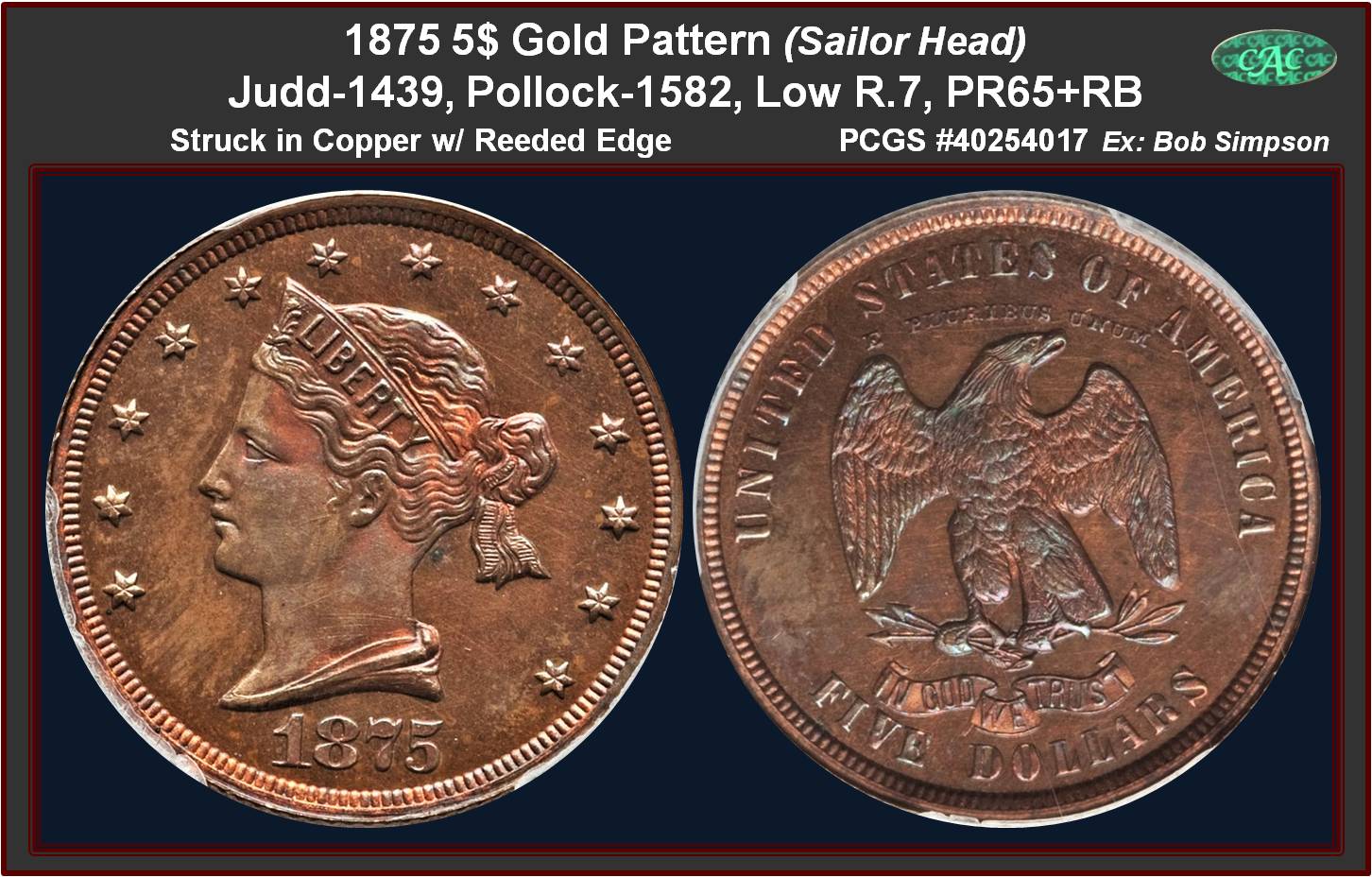
1875 $5 Sailor Head Five Dollar,
Judd-1439, Pollock-1582,
Rarity: Low R.7, PR65+ RB, CAC endorsed
Ex: Simpson.
Struck in copper with a reeded edge.
Obverse: William Barber's "Sailor Head" design with a left facing bust of Liberty on the obverse encircled by 13 stars around the periphery. Liberty is wearing a coronet inscribed LIBERTY, the date 1875 is in the exergue.
Reverse: An eagle that is very similar to that used on both the Trade dollar and the twenty cent piece dominates the center of the reverse. E PLURIBUS UNUM is in the field above the eagle's head, the motto IN GOD WE TRUST is on a scroll in the lower field, and the legend and denomination are around the borders.
Comment:
This design was also used on twenty cent and eagle patterns of 1875, dollar patterns of 1876 and 1877, and dime, quarter, half dollar, and dollar patterns. About a dozen pieces are known in copper, several of them gilt. On this piece a significant portion of original reddish-yellow mint luster survives on each side, but blue-brown patina is also seen, especially over the central devices.
Die Alignment 180 Deg
In the auction “COIN A ND CURIOSITY SALE” By Messer Thomas Birch and Sons on March 30, 1876 lot 328 and 329 were a 2 copper pieces - a J1439 (5$) and J1444 ($10), as we know them today. However this may have been the 1st time that Director Linderman was aware that these patterns made their way out of the mint and into private hands evident by this letter to Pollock that he sent.
3/28/1876 - Director Linderman to Superintendent Pollock:
 Sir: Your attention is invited to items 328-329 page 19 of the enclosed catalogue, from which it would appear that two experimental pieces, copper proofs of an Eagle and Half Eagle of 1875 are offered for sale and the statement made that only five pieces of each specimen have been struck. The pieces referred to, appear to have been received from some officer of the Mint, and I will thank you to make the necessary inquiry, and inform me how they found their way out of the Mint. Sir: Your attention is invited to items 328-329 page 19 of the enclosed catalogue, from which it would appear that two experimental pieces, copper proofs of an Eagle and Half Eagle of 1875 are offered for sale and the statement made that only five pieces of each specimen have been struck. The pieces referred to, appear to have been received from some officer of the Mint, and I will thank you to make the necessary inquiry, and inform me how they found their way out of the Mint.
Provenance/Appearances:
Ex: Bob Simpson Heritage Aug 2001 ANA WFOM Auction / Lot #3197, Prior Bowers and Merena, Aug 12 1996 The Rarities Sale / Lot #485 (64RB)
=====================================================================
Sailer Head Gold Patterns
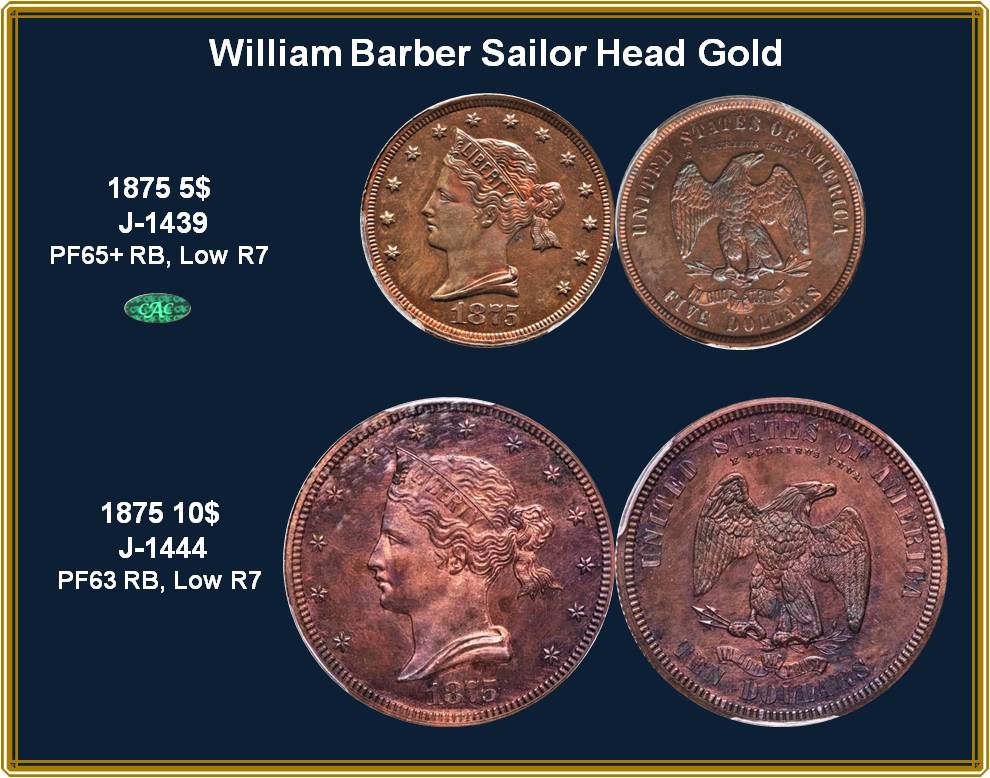
|

|
|
View Coin
| J-1444 G10$
Struck in Copper
Sailor Head |
United States
|
$10 1875 J-1444
|
PCGS PF 63 Red Brown
|

1875 10$ Eagle Sailor Head
Judd-1444, Pollock-1588
Rarity: Low R.7
Struck in copper with a reeded edge
Obverse:
William Barber's Sailor Head design with a bust of Liberty facing left with thirteen stars encircle the periphery and the date 1875 is below.. She wears a coronet inscribed LIBERTY with a spray ornamenting the head piece. Her hair tied back with a ribbon The drapery that surrounds her shoulders is said to appear to be a collar that wold have appeared on a sailor uniform thus the terms "SAILOR HEAD"
Reverse:
An eagle that is very similar to that employed on the regular issue twenty cent piece and Trade dollar dominates the reverse. The legend UNITED STATES OF AMERICA is at the upper border and the denomination TEN DOLLARS is at the bottom. In addition, E PLURIBUS UNUM is in the field above and the motto IN GOD WE TRUST is on a scroll below the eagle.
Comment:
An attractive and RARE pattern for a proposed design change for the $10. Bold underlying mirrors show off a rich bronze patina while the surfaces are toned with a violet-cobalt blend that is dappled on the generally smooth surfaces. The design elements are very crisply struck and show full definition on both sides. The visual allure is original and very pleasing ��About a dozen pieces are known, a few of which have been gilt.. An attractive example of this popular design type.
In the auction “COIN A ND CURIOSITY SALE” By Messer Thomas Birch and Sons on March 30, 1876 lot 328 and 329 were a 2 copper pieces - a J1439 (5$) and J1444 ($10), as we know them today. However this may have been the 1st time that Director Linderman was aware that these patterns made their way out of the mint and into private hands evident by this letter to Pollock that he sent.
3/28/1876 - Director Linderman to Superintendent Pollock:
 Sir: Your attention is invited to items 328-329 page 19 of the enclosed catalogue, from which it would appear that two experimental pieces, copper proofs of an Eagle and Half Eagle of 1875 are offered for sale and the statement made that only five pieces of each specimen have been struck. The pieces referred to, appear to have been received from some officer of the Mint, and I will thank you to make the necessary inquiry, and inform me how they found their way out of the Mint. Sir: Your attention is invited to items 328-329 page 19 of the enclosed catalogue, from which it would appear that two experimental pieces, copper proofs of an Eagle and Half Eagle of 1875 are offered for sale and the statement made that only five pieces of each specimen have been struck. The pieces referred to, appear to have been received from some officer of the Mint, and I will thank you to make the necessary inquiry, and inform me how they found their way out of the Mint.
Provenance:
The Collection of William Rau Heritage April 2018 CSNS - Chicago / Lot #5105 Legends rare Coin Auctions Regency #27 July 2018, Great Collections March 2021, earlier appears similar to Black and White photo Lot 1524 Bowers & Merena June 2001 The Lake Geneva Sale
|

|
|
View Coin
| |
United States
|
$5 1878 J-1568 GILT Bass Collection
|
NGC PF 61
|

1878 $5 Five Dollar,
Judd-1568a, Pollock-1759,
Rarity Low R.7, PR61 Gilt
Ex: HW Bass, Jr. Collection & Pollock Plate Coin Fig 487
Struck in copper with a reeded edge.
Obverse: Head of liberty facing left with motto - E PLURIBUS UNUM around the bust and with date 1878 below. The bust neck almost touches the millings. Liberty hair is tied in a bun, and a band extending back from Liberty forehead is inscribed LIBERTY.
Reverse: Eagle with spread wings holding an olive branch in its right talon and 3 arrows in its right. United States of America is above the eagle and denomination FIVE DOLLARS.
Comment:
These pieces were struck on thinner and slightly wider -- 25.5 mm vs 21.5 mm -- planchets than the regular issue. About a dozen examples are known. The bright gilt surfaces show no breaks in the layer of gilt, just a few spots widely scattered over each side The diameter is considerable larger than the 5 $ gold pieces.
Scattered toning spots are evident on both sides of this sharply detailed proof that displays reflective fields and lovely chocolate-brown surfaces. USPatterns.com identifies four examples of Judd-1573, including two gilt and two non-gilt and one of these is impounded at the Connecticut State Library. One or two others may exist.
63.7 Grains, 1.002”Diameter
Provenance/Appearances:
From The Estate of Charles W. Montgomery, Heritage Nov 2023 /Lot #3936
Ex:Bass Collection (Bowers and Merena, 5/1999) Lot #1365 ; Purchased From Lee Herwitt, April 17, 1972.
Plate coin for Pollock’s Pattern reference as figure 487
Plate Coin NGC Coin Explorer site for type
|

|
|
View Coin
| |
United States
|
$5 1878 J-1573
|
PCGS PF 64 Brown
|

1878 $5 Five Dollar,
Judd-1573, Pollock-1762,
Rarity High R.7, PR64 BN
Ex: HW Bass, Jr. Collection & Pollock Plate Coin Fig 489
Struck in copper with a reeded edge.
Obverse: Head of liberty facing left with motto using pellets - E * PLURIBUS * UNUM around the bust and with date 1878 below. The bust neck almost touches the millings. Liberty hair is tied in a bun, and a band extending back from Liberty forehead is inscribed LIBERTY.
Reverse: Eagle with spread wings holding an olive branch in its right talon and 3 arrows in its right. United States of America is above the eagle and denomination FIVE DOLLARS is below with a Period on each side.
Comment:
Judd-1573 is one of several different 1878 five dollar patterns, many of which (including Judd-1573) were designed by George T. Morgan. Judd-1566 through Judd-1573a are similar, but Judd-1573 is identified by two characteristics. The required motto IN GOD WE TRUST is absent, and there are periods (or stops) between the peripheral legends on both the obverse and reverse. The diameter is considerable larger than the 5 $ gold pieces.
Scattered toning spots are evident on both sides of this sharply detailed proof that displays reflective fields and lovely chocolate-brown surfaces. USPatterns.com identifies four examples of Judd-1573, including two gilt and two non-gilt and one of these is impounded at the Connecticut State Library. One or two others may exist.
69.5 Grains, 1.004 Diameter
Provenance/Appearances:
From The Estate of Charles W. Montgomery, Heritage Nov 2023 /Lot #3209
Ex: Stanley Kesselman (8/1971); Harry W. Bass, Jr. (Bowers and Merena, 5/1999), lot 1370; Bowers and Merena (3/2000), lot 2042.
Plate coin for Pollock’s Pattern reference as figure 489
|

|
|
View Coin
| J-1574 5$
Flowing Hair
In copper gilt |
United States
|
$5 1878 J-1574 GILT
|
NGC PF 62
|

1878 $5 Half Eagle,
Judd-1574, Pollock-1766,
Rarity: High R.6, Gilt, PR62
Struck in a larger diameter copper and then gilted with Reeded Edge
Obverse: The William Barber Flowing Hair motif graces the obverse. Liberty faces left, wearing a headband eponymously inscribed. E PLURIBUS UNUM is above, the date 1878 below.
Reverse: An eagle with lowered wings in the center, with UNITED STATES OF AMERICA and E PLURIBUS UNUM around. The arrows are long and slender, their tips extending behind and past the eagle's wing, and the olive branch has six leaves.
Comment:
The series of 1878 half eagles, Judd-1568A through 1574A, were struck on larger-diameter, thinner planchets as anti-counterfeiting measures, in an effort to combat the plague of malefactors scooping out the center of a gold coin and replacing it with less-expensive metal (in the 1870s one of the less-expensive metals was platinum!).��This is a lightly hairlined example. The gilt surface does little to impede the bright flash of the proof mirrors. The strike is generally strong, but it is clear that die opposition had not been thoroughly thought through with this design as there is slight high-point softness noted on each side.
Provenance/ Appearances:
From Heritage Jan 2022 FUN Signature® Auction - Orlando / Lot #4280; Prior
- Heritage April 2019 Central States / Lot #3988;
- Heritage Jan 2015 FUN /Lot #6760;
- Stacks Jan 2003 Lot 2154
- New England Rare Coins Jan 1981 FUN Sale /Lot #1193
- Bowers & Ruddy Nov 1976 (Rivers Oaks Collection) Lot #1023
- Possible Kagins 7/79 Lot 939 and ex Farouk 1954
|

|
|
View Coin
| J-1576 5$ Gilt |
United States
|
$5 1878 J-1576 GILT
|
PCGS PF 63
|

1878 $5 Five Dollar
Judd-1576, Pollock-1769
Rarity: Low R.7, Gilt PR63
Ex Simpson
Struck in copper & Gilt with a reeded edge.
Obverse: A head of Liberty faces left with IN GOD WE TRUST above, and the date 1878 below. Liberty is wearing a large cap inscribed LIBERTY and it is ornamented with 2 wheat ears. There are 13 stars at the border arranged 7 left and 6 right.
Reverse: An eagle with upraised wings is seen on the reverse. E PLURIBUS UNUM is expressed in two lines over the eagle's head.
Comment:
This design is attributed to William Barber who was impressed with Gobrecht's sketches from the 1830s. USPatterns.com estimates there are a dozen pieces known in copper, and two examples are known in gold. This is a bright yellow-gold example with complete gilt surfaces. A reddish spot at the tip of the nose of Liberty is the only mentionable non-gilt variation in color on either side.
Provenance/Appearances:
Ex Simpson Heritage May 2022 CSNS / Lot #3657; Priors;
- ANR Aug 2006 (The Old West and Franklinton Collections) / Lot #945 (as NGC62);
- Stacks Jan 2000 / Lot# 2019 (NGC62))
|

|
|
View Coin
| J-1578 G5$
Phyrgian Head half eagles
In Copper |
United States
|
$5 1878 J-1578
|
PCGS PF 64 Red Brown
|
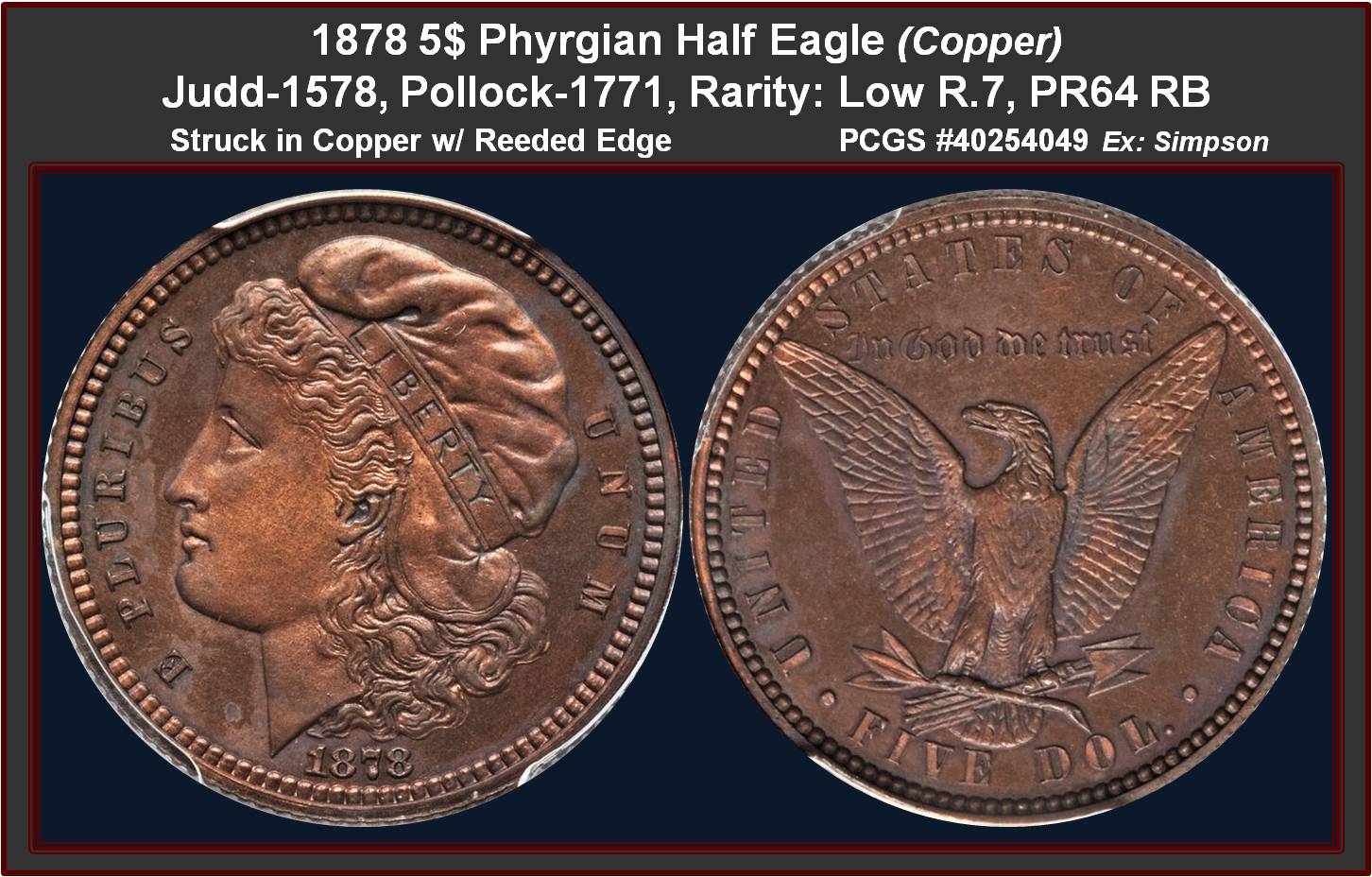
1878 $5 Half Eagle,
Judd-1578, Pollock-1771,
Low R.7, PR64 RB
Ex: Simpson.
Struck in copper with a reeded edge.
Obverse: The so-called Phrygian Head or Liberty Head obverse, attributed to George T. Morgan. Liberty wears a Phrygian cap, facing left, with LIBERTY incused on the band. E PLURIBUS is to the left, UNUM to the right, with date 1878 below.
Reverse: An upright eagle with spread wings and holding an olive sprig with 3 leaves and in his right talon holding 3 arrows. IN GOD WE TRUST is in Gothic script over the eagle, with FIVE DOL. at the rim below. UNITED STATES OF AMERICA is above and around at the boarder. Over all the eagle is similar to the Morgan dollar reverse but as noted by JUDD "except not as delicate“.
Struck on a regular-diameter planchet,
Comment:
About a dozen of these Phyrgian Head half eagles are known in copper, several of which have been gilted. This near-Gem survives in its natural state with glossy brown surfaces, and copper and violet accents.
Provenance:
Ex: Bob Simpson Heritage Aug 2021 ANA WFOM Auction / Lot #3212, Prior:
- Bowers & Merena Oct 1987 (The Bebee Collection) lot #1506;
- Bowers and Ruddy, Philip J. More Collection Auction April 1978 / Lot 2916 ($1600)
|

|
|
View Coin
| J-1752 2 1/2$
Struck in Aluminum
|
United States
|
2 1/2 $ 1885 J-1752
|
PCGS PF 65
|

1885 $2.50 Quarter Eagle,
Judd-1752, Pollock-1965
Rarity: R.8, PR65+ Cameo
(only 2 known)
Struck in aluminum with a reeded edge.
Obverse/Reverse; Struck from regular dies of 1885
Comment;
Although traditionally listed as regular dies trial striking's, these pieces were undoubtedly struck by the Mint for sale to collectors as part of complete aluminum sets.
The surfaces on this piece are typical for patterns struck in aluminum. The fields are deeply reflective, while the devices are heavily frosted. The combination produces the always-popular cameo-effect. Slight haziness is seen on each side. There is a pale golden patina on both sides likely from long storage in an envelope.
Only two pieces are known, and both are high-grade examples. In fact, since 1913 only 8 appearances of this pattern in auctions (this piece – 3 times and the Farouk/ Bob Simpson specimen which appeared 5 times)
It is curious to note die rust on the obverse, seen in the form of raised lumps both in the field before Liberty's neck as well as one her neck, another small patch of rust resides above star ten. This is more noteworthy as the other J-1752 aluminum quarter eagle does not show this feature-implying these have been struck at different times. Strange indeed
Provenance/Appearances:
Heritage Oct 2022 Long Beach Signature® Auction / Lot #3417 , Prior from the Linnemann Family Collection Stacks June 2013 Lot # 2346 ($15.275)
Plate Coin for USPatterns.com web site of J-1752
|

|
  
 | Loading… |
|
|